Paul van Yperen's Blog, page 284
January 15, 2018
Wera Frydtberg
German film, television and stage actress Wera Frydtberg (1926–2008) was a star of the German cinema of the 1950s. She appeared in leading roles in Ich denke oft an Piroschka/I Often Think of Piroschka (1955) and Wir Wunderkinder/Aren't We Wonderful? (1958).
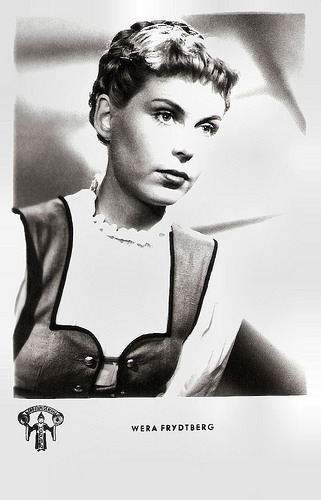
West-German postcard by Netter's Starverlag, Berlin, no. A 1201. Photo: Kopp-Filmverleih. Publicity still for Das Kreuz am Jägersteig/The Hunter's Cross (Hermann Kugelstadt, 1954).
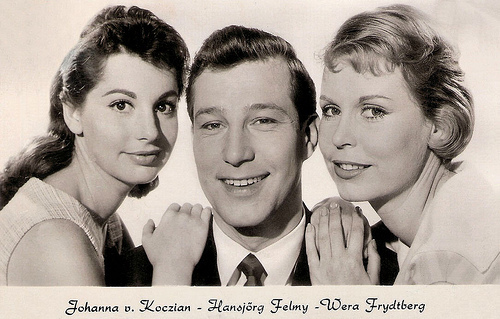
Dutch postcard by Gebr. Spanjersberg N.V., Rotterdam, no. 5338. Sent by mail in the Netherlands in 1960. Photo: HAFBO-film. Publicity still for Wir Wunderkinder/Aren't We Wonderful? (Kurt Hoffmann, 1958) with Johanna von Koczian and Hansjörg Felmy .
The Sinner
Wera Frydtberg was born as Wera Friedberg in 1926 in Freiburg im Breisgau, Germany. Her father was a physician.
She studied acting with professor Neugebauer in Vienna. She made her theatrical debut in 1949 and became prominent in the Wirtschaftwunder cinema of the 1950s.
She made her film debut in a supporting part in the melodramatic Film Noir Die Sünderin/The Sinner (Willi Forst, 1951). In her role as a prostitute, leading star Hildegard Knef created a sensation with a brief nude scene.
The film drew the criticism of the Roman Catholic Church. Contrary to common believe in later years, at the time of the release the nude scene was not the main issue for the protests but the depiction of prostitution, euthanasia and suicide as a good or even logical way to act. The opposition reached the degree of banning the film and scandalising it which paradoxically made it one of the landmarks in the history of the German cinema.
In the following years, Frydtberg played supporting parts in several comedies and had a guest role in the American-German TV series Flash Gordon (1954) featuring Steve Holland as the space hero.
Frydtberg had her first leading role in the Heimatfilm Das Forsthaus in Tirol/The Forest House in Tyrol (Hermann Kugelstadt, 1955) opposite Helmuth Schneider .
Very popular was the charming and melancholic comedy Ich denke oft an Piroschka/I Often Think of Piroschka (Kurt Hoffmann, 1955), in which she co-starred with Liselotte Pulver as Piroschka and Gunnar Möller.
During a train journey, the writer Andreas nostalgically recalls a holiday trip he had made thirty years before in 1920s Hungary to the Lake Balaton area. While there he had enjoyed his first true romance with the daughter of the local stationmaster. The film is in the Heimatfilm tradition which was at its height when the film was released.
Other notable films with Frydtberg include the comedy Der Pauker/The Crammer (Axel von Ambesser, 1958), starring Heinz Rühmann , and Wir Wunderkinder/Aren't We Wonderful? (Kurt Hoffmann, 1958), with Johanna von Koczian and Hansjörg Felmy . The latter recounts the lives of two schoolmates, Hans Boeckel and Bruno Tiches from the fictional town of Neustadt an der Nitze, against the backdrop of German history in the first half of the 20th century.
Eleanor Mannikka at AllMovie : “A biting and effective semi-experimental film about Nazism in Germany, director Kurt Hoffmann tells the story in a long flashback, starting in 1913 and playing out like a silent movie on a small screen.” The film received numerous awards. Most notably, it won the Golden Globe for Best International Picture in 1960.
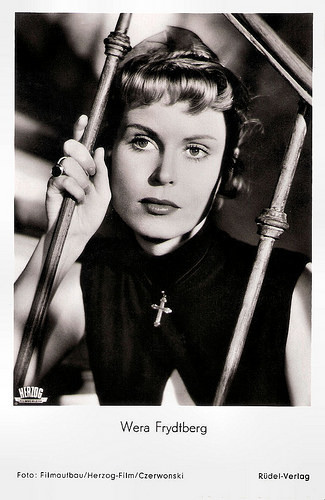
German postcard by Rüdel-Verlag, Hamburg-Bergedorf, no. 984. Photo: Filmaufbau / Herzog-Film / Czerwonski. Publicity still for Sie/She (Rolf Thiele, 1954).
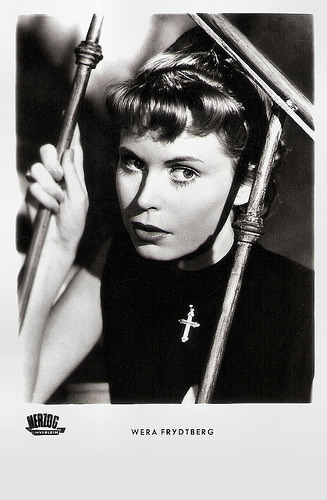
German postcard by Netter's Starverlag, Berlin, no. A 1205. Photo: Herzog Filmverleih. Publicity still for Sie/She (Rolf Thiele, 1954).
The Land of Smiles
During the 1960s, Wera Frydtberg focused more on TV and appeared in operetta adaptations as Der Vogelhändler/The Bird Seller (Kurt Wilhelm, 1960) and Das Land des Lächelns/The Land of Smiles (Kurt Wilhelm, 1961).
During her career, she also appeared extensively on stage in Vienna at the Akademie-Theater, the Kosmos-Theater and till 1962 at the Theater in der Josefstadt. In Germany she played guest parts at the Renaissance-Theater in Berlin, the Komödie Berlin, at the Kleine Komödie in Munich, at the Komödie Düsseldorf, at the Theater Die Kleine Freiheit in Munich and at the Schlosspark-Spielen Wiesbaden.
In the cinema, she appeared in such mediocre fare as the Austrian Schlagerfilm Sing, aber spiel nicht mit mir/Sing but don’t play with me (Kurt Nachmann, 1963) with Adrian Hoven .
More interesting was the drama Das Glück läuft hinterher/Happiness is running afterwards (Peter Beauvais, 1963), which follows the life of several different people in 1960s in Germany for a few days.
She guest-starred in popular Krimi series like Der Kommissar/The Commissioner (1972-1973) and Ein Fall für zwei/A case for two (1982).
Her final feature film was the comedy Mein Onkel Theodor oder Wie man viel Geld im Schlaf verdient/My uncle Theodor (Gustav Ehmck, 1975) with Gert Fröbe and Barbara Rütting . Her last screen appearance was in the Krimi series München 7/Munich 7 (2006).
Wera Frydtberg died 2008 in Munich, Bavaria, Germany at the age of 81. She was married to American immigrant and officer Otto Urbach till his death in 1976. They had one daughter, historian Karina Urbach.
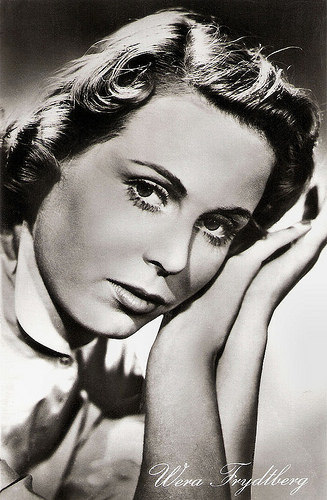
East-German postcard by VEB Progress Film-Vertrieb, Berlin, no. 34/327, 1957. Photo: Real-Film. Publicity still for Die tolle Lola/The great Lola (Hans Deppe, 1954).

East-German postcard by VEB Progress Film-Vertrieb, Berlin, no. 1061, 1965.
Sources: Eleanor Mannikka (AllMovie), Stephanie D’heil (Steffi-Line - German), Wikipedia (German and English) and .

West-German postcard by Netter's Starverlag, Berlin, no. A 1201. Photo: Kopp-Filmverleih. Publicity still for Das Kreuz am Jägersteig/The Hunter's Cross (Hermann Kugelstadt, 1954).

Dutch postcard by Gebr. Spanjersberg N.V., Rotterdam, no. 5338. Sent by mail in the Netherlands in 1960. Photo: HAFBO-film. Publicity still for Wir Wunderkinder/Aren't We Wonderful? (Kurt Hoffmann, 1958) with Johanna von Koczian and Hansjörg Felmy .
The Sinner
Wera Frydtberg was born as Wera Friedberg in 1926 in Freiburg im Breisgau, Germany. Her father was a physician.
She studied acting with professor Neugebauer in Vienna. She made her theatrical debut in 1949 and became prominent in the Wirtschaftwunder cinema of the 1950s.
She made her film debut in a supporting part in the melodramatic Film Noir Die Sünderin/The Sinner (Willi Forst, 1951). In her role as a prostitute, leading star Hildegard Knef created a sensation with a brief nude scene.
The film drew the criticism of the Roman Catholic Church. Contrary to common believe in later years, at the time of the release the nude scene was not the main issue for the protests but the depiction of prostitution, euthanasia and suicide as a good or even logical way to act. The opposition reached the degree of banning the film and scandalising it which paradoxically made it one of the landmarks in the history of the German cinema.
In the following years, Frydtberg played supporting parts in several comedies and had a guest role in the American-German TV series Flash Gordon (1954) featuring Steve Holland as the space hero.
Frydtberg had her first leading role in the Heimatfilm Das Forsthaus in Tirol/The Forest House in Tyrol (Hermann Kugelstadt, 1955) opposite Helmuth Schneider .
Very popular was the charming and melancholic comedy Ich denke oft an Piroschka/I Often Think of Piroschka (Kurt Hoffmann, 1955), in which she co-starred with Liselotte Pulver as Piroschka and Gunnar Möller.
During a train journey, the writer Andreas nostalgically recalls a holiday trip he had made thirty years before in 1920s Hungary to the Lake Balaton area. While there he had enjoyed his first true romance with the daughter of the local stationmaster. The film is in the Heimatfilm tradition which was at its height when the film was released.
Other notable films with Frydtberg include the comedy Der Pauker/The Crammer (Axel von Ambesser, 1958), starring Heinz Rühmann , and Wir Wunderkinder/Aren't We Wonderful? (Kurt Hoffmann, 1958), with Johanna von Koczian and Hansjörg Felmy . The latter recounts the lives of two schoolmates, Hans Boeckel and Bruno Tiches from the fictional town of Neustadt an der Nitze, against the backdrop of German history in the first half of the 20th century.
Eleanor Mannikka at AllMovie : “A biting and effective semi-experimental film about Nazism in Germany, director Kurt Hoffmann tells the story in a long flashback, starting in 1913 and playing out like a silent movie on a small screen.” The film received numerous awards. Most notably, it won the Golden Globe for Best International Picture in 1960.

German postcard by Rüdel-Verlag, Hamburg-Bergedorf, no. 984. Photo: Filmaufbau / Herzog-Film / Czerwonski. Publicity still for Sie/She (Rolf Thiele, 1954).

German postcard by Netter's Starverlag, Berlin, no. A 1205. Photo: Herzog Filmverleih. Publicity still for Sie/She (Rolf Thiele, 1954).
The Land of Smiles
During the 1960s, Wera Frydtberg focused more on TV and appeared in operetta adaptations as Der Vogelhändler/The Bird Seller (Kurt Wilhelm, 1960) and Das Land des Lächelns/The Land of Smiles (Kurt Wilhelm, 1961).
During her career, she also appeared extensively on stage in Vienna at the Akademie-Theater, the Kosmos-Theater and till 1962 at the Theater in der Josefstadt. In Germany she played guest parts at the Renaissance-Theater in Berlin, the Komödie Berlin, at the Kleine Komödie in Munich, at the Komödie Düsseldorf, at the Theater Die Kleine Freiheit in Munich and at the Schlosspark-Spielen Wiesbaden.
In the cinema, she appeared in such mediocre fare as the Austrian Schlagerfilm Sing, aber spiel nicht mit mir/Sing but don’t play with me (Kurt Nachmann, 1963) with Adrian Hoven .
More interesting was the drama Das Glück läuft hinterher/Happiness is running afterwards (Peter Beauvais, 1963), which follows the life of several different people in 1960s in Germany for a few days.
She guest-starred in popular Krimi series like Der Kommissar/The Commissioner (1972-1973) and Ein Fall für zwei/A case for two (1982).
Her final feature film was the comedy Mein Onkel Theodor oder Wie man viel Geld im Schlaf verdient/My uncle Theodor (Gustav Ehmck, 1975) with Gert Fröbe and Barbara Rütting . Her last screen appearance was in the Krimi series München 7/Munich 7 (2006).
Wera Frydtberg died 2008 in Munich, Bavaria, Germany at the age of 81. She was married to American immigrant and officer Otto Urbach till his death in 1976. They had one daughter, historian Karina Urbach.

East-German postcard by VEB Progress Film-Vertrieb, Berlin, no. 34/327, 1957. Photo: Real-Film. Publicity still for Die tolle Lola/The great Lola (Hans Deppe, 1954).

East-German postcard by VEB Progress Film-Vertrieb, Berlin, no. 1061, 1965.
Sources: Eleanor Mannikka (AllMovie), Stephanie D’heil (Steffi-Line - German), Wikipedia (German and English) and .
Published on January 15, 2018 22:00
January 14, 2018
Bernard Giraudeau
French actor Bernard Giraudeau (1947-2010) was with his bright blue eyes one of the most attractive but also talented stars of the French cinema. For his roles, he was twice nominated for the French Oscar, Le César. Giraudeau also worked as film director, scriptwriter, producer and writer.
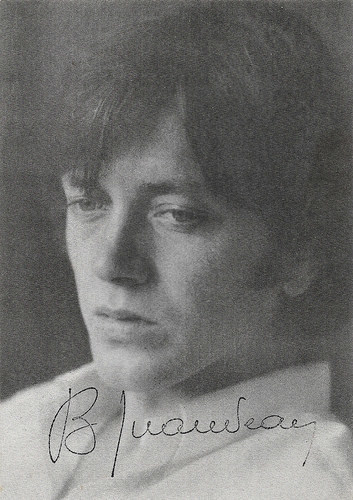
French autograph card.
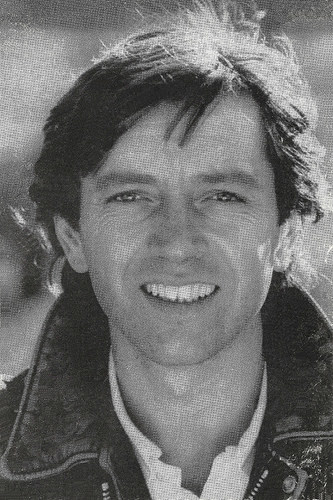
French postcard in the Acteurs Français series by Les Editions Gil, no. 5.
Passion of Love
Bernard René Giraudeau was born in 1947 in La Rochelle, France.
In 1963 the 15-years-old enlisted in the French navy as a trainee engineer, qualifying as the first in his class a year later. He completed two around the world cruises before his service ended. He served on the helicopter carrier Jeanne d'Arc in 1964–1965 and 1965–1966, and subsequently on the frigate Duquesne and the aircraft carrier Clemenceau before leaving the navy to try his luck as an actor.
He studied acting at the CNSAD (Conservatoire National Superieur d'Art Dramatique). Giraudeau first appeared on film in the Franco-Italian crime film Deux hommes dans la ville/Two men in Town (José Giovanni, 1973) starring Jean Gabin and Alain Delon . He played a kidnapper in Revolver (Sergio Sollima, 1973) with Oliver Reed.
Two years later he had a supporting part in another crime drama by José Giovanni, Le Gitan/The Gypsy (José Giovanni, 1975), starring Alain Delon and Annie Girardot .
In 1977, he played the male lead in Bilitis (1977) directed by photographer David Hamilton with a music score by Francis Lai. The erotic and romantic coming-of-age drama starred Patti D'Arbanville as Bilitis. The film was shot in the soft-focus schmaltz style that was common of David Hamilton's at the time very popular photography.
Giraudeau also co-starred with Jodie Foster in the French film Moi, fleur bleue/Stop Calling Me Baby! (Eric le Hung, 1977). He co-starred again with Alain Delon in the futuristic war film Le Toubib/The Medic (Pierre Granier-Deferre, 1979), and appeared in the hit comedy Boum/The Party (Claude Pinoteau, 1980) with Sophie Marceau in her film debut.
Then followed his breakthrough as a handsome dashing officer who falls desperately in love with an ugly but passionate woman (Valeria d’Obici) in the Italian drama Passione d'amore/Passion of Love (Ettore Scola, 1981). The film was entered into the 1981 Cannes Film Festival and served as the inspiration for the 1994 Broadway musical Passion by Stephen Sondheim and James Lapine.
Soon followed leading roles in international films like the French-Swiss drama Hecate (Daniel Schmid, 1982) with Lauren Hutton, the French-Canadian crime film Le Ruffian/The Ruffian (José Giovanni, 1983) also starring Lino Ventura and Claudia Cardinale , and the French drama L'année des méduses/The Year of the Jellyfish (Christopher Frank, 1985) with Valérie Kaprisky .
Another box-office hit in France was the buddy-action film Les Spécialistes/The Specialists (Patrice Leconte, 1985). in which he co-starred with Gérard Lanvin . DB Dumonteil at IMDb : “A deft, energetic buddy movie interspersed with unexpected twists, suspenseful chases and stunts and a sharp humor into the bargain. Everything you could wish for to spend a comfortable evening in front of the telly without reservations. (…) One shouldn't forget the two main actors which contribute in making the film a little winner. Gérard Lanvin and Bernard Giraudeau are on top form.”
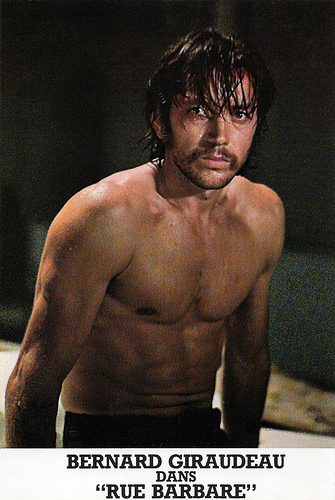
French autograph card. Photo: Luc Roux, Première. Publicity still for Rue barbare/Barbarous Street (Gilles Béhat, 1984).
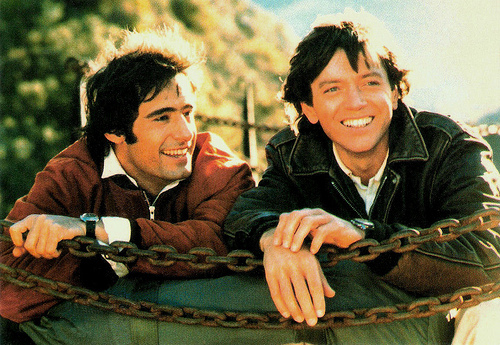
French postcard by Les Editions Gil in the série acteurs, no. 3. Publicity still for Les Spécialistes/The Specialists (1985, Patrice Leconte) with Gérard Lanvin .
Water Drops on Burning Rocks
In 1987, Bernard Giraudeau made his first film as director the TV film La Face de l'ogre/The Face of the Monster (1988), though he continued to work as an actor.
He co-starred with Isabelle Huppert in the romance Après l'amour/Love After Love (Diane Kurys, 1992). In the drama Le Fils préferé/The Favourite Son (Nicole Garcia, 1994), he played the brother of Gérard Lanvin and Jean-Marc Barr .
Giraudeau appeared in the lauded historical drama Ridicule (Patrice Leconte, 1996), set in the 18th century at the decadent court of Versailles. The film won the Palme d’Or at the Cannes Film Festival and received several César awards, but Giraudeau was only nominated for a Cesar as best Supporting Actor.
He played Molière in another historical film, Marquise (Véra Belmont, 1997) with Sophie Marceau and Lambert Wilson . In Italy he appeared in the drama Marianna Ucrìa (Roberto Faenza, 1997).
Back in France he starred in François Ozon’s drama Gouttes d'eau sur pierres brûlantes/Water Drops on Burning Rocks (2000), based on a German play by Rainer Werner Fassbinder , Tropfen auf heisse Steine, written when he was 19 years old. Elbert Ventura at AllMovie : “The movie has an undercurrent of absurdist humor, but its laughs are muffled for the most part, with the exception being an out-of-left-field dance number that injects some needed energy into the dour, claustrophobic story. Beautifully structured and meticulously filmed, Water Drops on Burning Rocks is clearly the work of an intelligent filmmaker.”
Also interesting is Une affaire de goût/A Question of Taste (Bernard Rapp, 2000). The film tells about the growing dependency between a rich CEO (Giraudeau) and a handsome young waiter (Jean-Pierre Lorit) whom the CEO hires at an astronomical sum to serve as a personal food taster. David Anderson at Bunched Undies : “A Matter of Taste is a well-executed film: excellent production, nicely photographed and well-acted. But by the time it’s over, like the principle characters, you may find yourself feeling a bit empty.” The film received 5 César Award nominations, including nominations for Best Film and for Giraudeau as Best Actor.

French postcard in the Collection 9.1/2 series by Editions Humour à la Carte, Paris, no. ST-63. Sent by mail in 2000.
The Hook
As a writer, Bernard Giraudeau wrote the text of books of photography and published children's stories (Contes d'Humahuaca, 2002) and several novels. He was also the reader on the French audio books of the Harry Potter series.
Since 1976, he was married to actress and author Anny Duperey , whom he had met while acting in the same play. They acted together on-screen in several productions, including the crime drama Le grand pardon/Grand Pardon (Alexandre Arcady, 1982), Meurtres à domicile/Evil in the house (Marc Lobet, 1982), La face de l'ogre (Bernard Giraudeau, 1988), and Contre l'oubli/Against Oblivion (Bernard Giraudeau a.o., 1991). They divorced in 1993.
From 1996 to his death, he was the companion of Tohra Mahdavi. Giraudeau and Duperey had two children: son Gaël and daughter Sara. Sara Giraudeau achieved success as an actress.
In 2000 Bernard Giraudeau suffered a cancer which led to the removal of his left kidney, with a subsequent metastasis in 2005 affecting his lungs. He said that the cancer led him to re-evaluate his life and understand himself better.
He devoted some of his time to the support of cancer victims through the Institut Curie and the Institut Gustave-Roussy in Paris.
His later films included La petite Lili/Little Lili (Claude Miller, 2003), featuring Ludivine Sagnier, the comedy Ce jour-là/That Day (Raúl Ruiz, 2003), and the thriller Je suis un assassin/The Hook (Thomas Vincent, 2004) with François Cluzet and Karin Viard.
In 2010, Bernard Giraudeau died of his cancer in a Paris hospital. He was 63.
Trailer Gouttes d'eau sur pierres brûlantes/Water Drops on Burning Rocks (2000). Source: Accent Film Entertainment (YouTube).
French trailer Une affaire de goût/A Question of Taste (2000). Source: jajuvabie (YouTube).
Sources: David Anderson (Bunched Undies), DB Dumonteil (IMDb), Elbert Ventura (AllMovie), Wikipedia and .

French autograph card.

French postcard in the Acteurs Français series by Les Editions Gil, no. 5.
Passion of Love
Bernard René Giraudeau was born in 1947 in La Rochelle, France.
In 1963 the 15-years-old enlisted in the French navy as a trainee engineer, qualifying as the first in his class a year later. He completed two around the world cruises before his service ended. He served on the helicopter carrier Jeanne d'Arc in 1964–1965 and 1965–1966, and subsequently on the frigate Duquesne and the aircraft carrier Clemenceau before leaving the navy to try his luck as an actor.
He studied acting at the CNSAD (Conservatoire National Superieur d'Art Dramatique). Giraudeau first appeared on film in the Franco-Italian crime film Deux hommes dans la ville/Two men in Town (José Giovanni, 1973) starring Jean Gabin and Alain Delon . He played a kidnapper in Revolver (Sergio Sollima, 1973) with Oliver Reed.
Two years later he had a supporting part in another crime drama by José Giovanni, Le Gitan/The Gypsy (José Giovanni, 1975), starring Alain Delon and Annie Girardot .
In 1977, he played the male lead in Bilitis (1977) directed by photographer David Hamilton with a music score by Francis Lai. The erotic and romantic coming-of-age drama starred Patti D'Arbanville as Bilitis. The film was shot in the soft-focus schmaltz style that was common of David Hamilton's at the time very popular photography.
Giraudeau also co-starred with Jodie Foster in the French film Moi, fleur bleue/Stop Calling Me Baby! (Eric le Hung, 1977). He co-starred again with Alain Delon in the futuristic war film Le Toubib/The Medic (Pierre Granier-Deferre, 1979), and appeared in the hit comedy Boum/The Party (Claude Pinoteau, 1980) with Sophie Marceau in her film debut.
Then followed his breakthrough as a handsome dashing officer who falls desperately in love with an ugly but passionate woman (Valeria d’Obici) in the Italian drama Passione d'amore/Passion of Love (Ettore Scola, 1981). The film was entered into the 1981 Cannes Film Festival and served as the inspiration for the 1994 Broadway musical Passion by Stephen Sondheim and James Lapine.
Soon followed leading roles in international films like the French-Swiss drama Hecate (Daniel Schmid, 1982) with Lauren Hutton, the French-Canadian crime film Le Ruffian/The Ruffian (José Giovanni, 1983) also starring Lino Ventura and Claudia Cardinale , and the French drama L'année des méduses/The Year of the Jellyfish (Christopher Frank, 1985) with Valérie Kaprisky .
Another box-office hit in France was the buddy-action film Les Spécialistes/The Specialists (Patrice Leconte, 1985). in which he co-starred with Gérard Lanvin . DB Dumonteil at IMDb : “A deft, energetic buddy movie interspersed with unexpected twists, suspenseful chases and stunts and a sharp humor into the bargain. Everything you could wish for to spend a comfortable evening in front of the telly without reservations. (…) One shouldn't forget the two main actors which contribute in making the film a little winner. Gérard Lanvin and Bernard Giraudeau are on top form.”

French autograph card. Photo: Luc Roux, Première. Publicity still for Rue barbare/Barbarous Street (Gilles Béhat, 1984).

French postcard by Les Editions Gil in the série acteurs, no. 3. Publicity still for Les Spécialistes/The Specialists (1985, Patrice Leconte) with Gérard Lanvin .
Water Drops on Burning Rocks
In 1987, Bernard Giraudeau made his first film as director the TV film La Face de l'ogre/The Face of the Monster (1988), though he continued to work as an actor.
He co-starred with Isabelle Huppert in the romance Après l'amour/Love After Love (Diane Kurys, 1992). In the drama Le Fils préferé/The Favourite Son (Nicole Garcia, 1994), he played the brother of Gérard Lanvin and Jean-Marc Barr .
Giraudeau appeared in the lauded historical drama Ridicule (Patrice Leconte, 1996), set in the 18th century at the decadent court of Versailles. The film won the Palme d’Or at the Cannes Film Festival and received several César awards, but Giraudeau was only nominated for a Cesar as best Supporting Actor.
He played Molière in another historical film, Marquise (Véra Belmont, 1997) with Sophie Marceau and Lambert Wilson . In Italy he appeared in the drama Marianna Ucrìa (Roberto Faenza, 1997).
Back in France he starred in François Ozon’s drama Gouttes d'eau sur pierres brûlantes/Water Drops on Burning Rocks (2000), based on a German play by Rainer Werner Fassbinder , Tropfen auf heisse Steine, written when he was 19 years old. Elbert Ventura at AllMovie : “The movie has an undercurrent of absurdist humor, but its laughs are muffled for the most part, with the exception being an out-of-left-field dance number that injects some needed energy into the dour, claustrophobic story. Beautifully structured and meticulously filmed, Water Drops on Burning Rocks is clearly the work of an intelligent filmmaker.”
Also interesting is Une affaire de goût/A Question of Taste (Bernard Rapp, 2000). The film tells about the growing dependency between a rich CEO (Giraudeau) and a handsome young waiter (Jean-Pierre Lorit) whom the CEO hires at an astronomical sum to serve as a personal food taster. David Anderson at Bunched Undies : “A Matter of Taste is a well-executed film: excellent production, nicely photographed and well-acted. But by the time it’s over, like the principle characters, you may find yourself feeling a bit empty.” The film received 5 César Award nominations, including nominations for Best Film and for Giraudeau as Best Actor.

French postcard in the Collection 9.1/2 series by Editions Humour à la Carte, Paris, no. ST-63. Sent by mail in 2000.
The Hook
As a writer, Bernard Giraudeau wrote the text of books of photography and published children's stories (Contes d'Humahuaca, 2002) and several novels. He was also the reader on the French audio books of the Harry Potter series.
Since 1976, he was married to actress and author Anny Duperey , whom he had met while acting in the same play. They acted together on-screen in several productions, including the crime drama Le grand pardon/Grand Pardon (Alexandre Arcady, 1982), Meurtres à domicile/Evil in the house (Marc Lobet, 1982), La face de l'ogre (Bernard Giraudeau, 1988), and Contre l'oubli/Against Oblivion (Bernard Giraudeau a.o., 1991). They divorced in 1993.
From 1996 to his death, he was the companion of Tohra Mahdavi. Giraudeau and Duperey had two children: son Gaël and daughter Sara. Sara Giraudeau achieved success as an actress.
In 2000 Bernard Giraudeau suffered a cancer which led to the removal of his left kidney, with a subsequent metastasis in 2005 affecting his lungs. He said that the cancer led him to re-evaluate his life and understand himself better.
He devoted some of his time to the support of cancer victims through the Institut Curie and the Institut Gustave-Roussy in Paris.
His later films included La petite Lili/Little Lili (Claude Miller, 2003), featuring Ludivine Sagnier, the comedy Ce jour-là/That Day (Raúl Ruiz, 2003), and the thriller Je suis un assassin/The Hook (Thomas Vincent, 2004) with François Cluzet and Karin Viard.
In 2010, Bernard Giraudeau died of his cancer in a Paris hospital. He was 63.
Trailer Gouttes d'eau sur pierres brûlantes/Water Drops on Burning Rocks (2000). Source: Accent Film Entertainment (YouTube).
French trailer Une affaire de goût/A Question of Taste (2000). Source: jajuvabie (YouTube).
Sources: David Anderson (Bunched Undies), DB Dumonteil (IMDb), Elbert Ventura (AllMovie), Wikipedia and .
Published on January 14, 2018 22:00
January 6, 2018
Hans Söhnker
Hans Söhnker (1903-1981) was a German film actor. He appeared in 105 films between 1933 and 1980. The understatement and elegance of his acting was reminiscent of American film stars and made him an extraordinary presence in the German cinema.
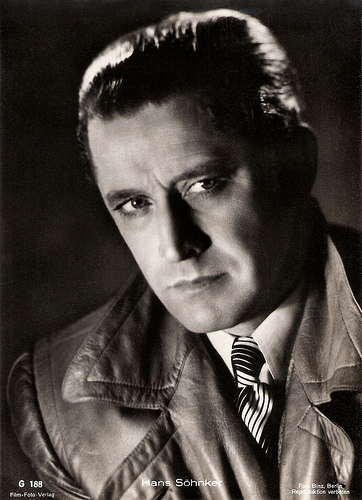
German postcard by Film-Foto-Verlag, no. G 188, 1941-1944. Photo: Binz, Berlin.
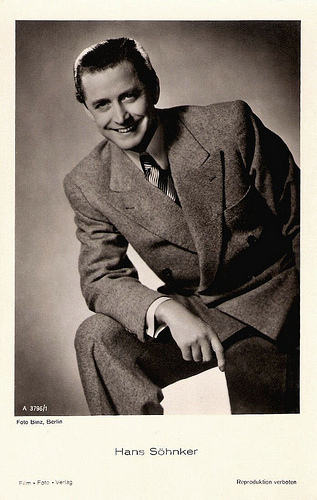
German postcard by Film-Foto-Verlag, no. A 3796/1, 1941-1944. Photo: Binz, Berlin.
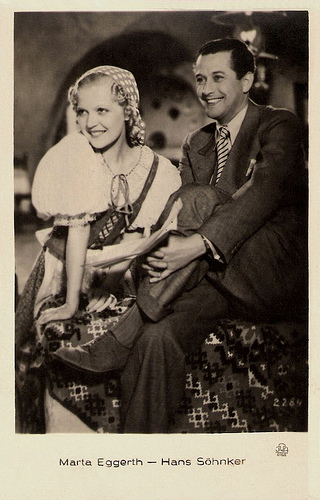
Latvian postcard., no. 2284. Photo: J. Rolin (?), Riga. With Martha Eggerth in Der Zarewitsch/The Czarevitch (Victor Janson, 1933).
Young, Careless Lover
Hans Albert Edmund Söhnker was born in Kiel in 1903. His father was a carpenter and a book-seller, and an active member of the Social Democratic Party.
After finishing school, Hans took up an apprenticeship in a warehouse and at the same time he started taking acting lessons from Clemens Schubert and Gustaf Gründgens. In 1922, he made his stage debut at the Stadttheater Kiel, and subsequently played in theatres in Frankfurt/Oder, Danzig, Chemnitz and Bremen.
He made screen tests for the Ufa, and was finally cast by Victor Janson as Martha Eggerth 's partner in Der Zarewitsch/The Czarevitch (Victor Janson, 1933). He reprised the role of the young and careless lover for Schwarzwaldmädel/The Black Forest Girl (Georg Zoch, 1933) and Die Csardasfürstin/The Czardas Princess (Georg Jacoby, 1934).
He avoided being typecast again and instead proved his ability to play more serious characters with Arzt aus Leidenschaft/Medicine Man (Hans H. Zerlett, 1936).
His other films include Jede Frau hat ein Geheimnis/Every Woman Has A Secret (Max Obal, 1934), Eva (Johannes Riemann, 1935), Diener lassen bitten/Dinner Is Served (Hans H. Zerlett, 1936), and Truxa (Hans H. Zerlett, 1936) starring La Jana .
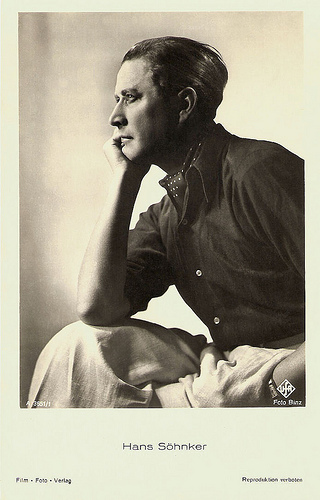
German postcard by Film-Foto-Verlag, no. A 3651/1, 1941-1944. Photo: Tita Binz / Ufa.
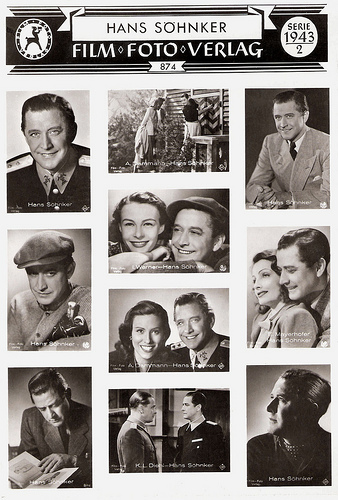
German presentation card by Film-Foto-Verlag, no. 874, series 1943/2.
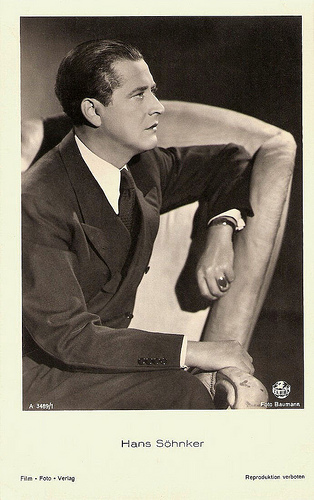
German postcard by Film-Foto-Verlag, no. A 3489/1, 1941-1944. Photo: Baumann / Terra.
Natural Charm
Hans Söhnker excelled as the romantic rival of both Heinz Rühmann in Der Mustergatte/Model Husband (Wolfgang Liebeneiner, 1937) and Hans Albers in Große Freiheit Nr. 7/Great Freedom No. 7 (1944).
The latter was directed by Helmut Käutner , who frequently cast Söhnker. Käutner put Söhnker's natural charm to its best use, for instance in Frau nach Maß/Customized Woman (Helmut Käutner, 1940) based on a play by Erich Kästner.
These films made him an Ufa-star in Nazi Germany. During the Third Reich he was also on the Gestapo's black list because he often helped and hid Jews.
After the war, Söhnker, who had always continued to work as a stage actor, returned to the theatre. He re-emerged as a film actor with Film ohne Titel/Film Without Title (1947), which was produced by Käutner and directed by Rudolf Jugert.
Jugert also cast Söhnker in the comedies Hallo Fräulein/Hello Fraulein (Rudolf Jugert, 1949) and Einmaleins der Ehe/Marriage – The Basics (Rudolf Jugert, 1949).
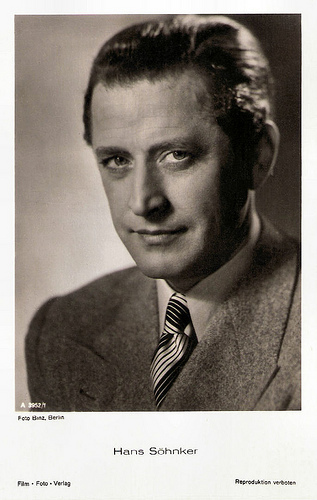
German postcard by Film-Foto-Verlag, no. A 3952/1, 1941-1944. Photo: Foto Binz, Berlin. From Tatiana.
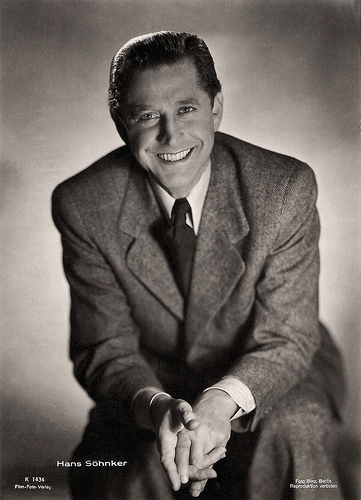
German postcard by Film-Foto-Verlag, no. K 1434. Photo: Tita Binz, Berlin.
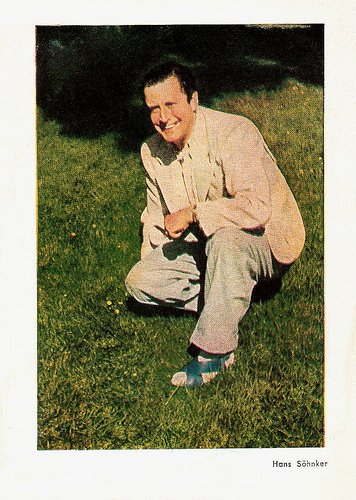
German postcard by Verlag und Druckerei Erwin Preuss, Dresden-Freital, series 1, no. 20. Photo: Charlott Serda.
Elegant Presence
His dramatic performances in Nur eine Nacht/Just One Night (Fritz Kirchhoff, 1950) with Marianne Hoppe , and Weiße Schatten/White Shadows (Helmut Käutner, 1951) again proved his ability to shift effortlessly between genres.
The well aged Söhnker remained an elegant presence in the German Post-War cinema of the 1950s. Films include Die Stärkere/The Stronger Ones (Wolfgang Liebeneiner, 1953), Hoheit lassen bitten/Majesty Allow To Plea (Paul Verhoeven, 1954), and Worüber man spricht/False Shame (Wolfgang Glück, 1958).
From the 1960s on, he starred in several successful TV series like Der Forellenhof/The Trout Farm (1965), Salto Mortale (1968), and Meine Schwiegersöhne und ich/My Sons-in-law and I (1969), which sustained Söhnker's popularity up to his old age.
He also made films like Unser Haus in Kamerun/Our House in Cameroun (Alfred Vohrer, 1961), Sherlock Holmes und das Halsband des Todes/Sherlock Holmes and the Deadly Necklace (Terence Fisher, Frank Winterstein, 1962) starring Christopher Lee , Sechs Stunden Angst/Six Hours of Terror (Eugen York, 1964), and the Edgar Wallace thriller Der Hund von Blackwood Castle/The Monster of Blackwood Castle (Alfred Vohrer, 1967).
In 1973 he was awarded Germany's Bundesverdienstktreuz, and in 1977 the Filmband in Gold for his lifetime achievements. He published his memoires ...und kein Tag zuviel/And Not A Day Too Many in 1974.
Hans Söhnker passed away in Berlin in 1981. He was twice married. Actress Anneke Kim Sarnau is his great-granddaughter.
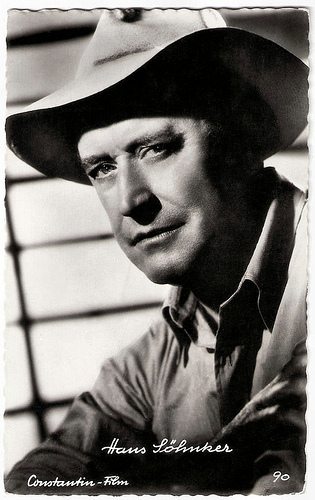
Austrian postcard by Verlag Hubmann (HDH Verlag), Wien, no. 90. Photo: Constantin-Film. Publicity still for Die Stärkere/The stronger (Wolfgang Liebeneiner, 1953).
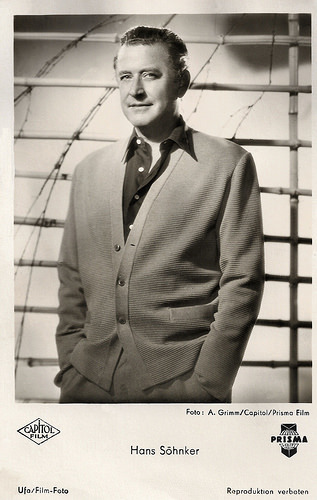
German postcard by Ufa, no. FK 573. Photo: Grimm / Capitol / Prisma Film. Publicity still for Ein Leben für Do/A Life for Do (Gustav Ucicky, 1954).
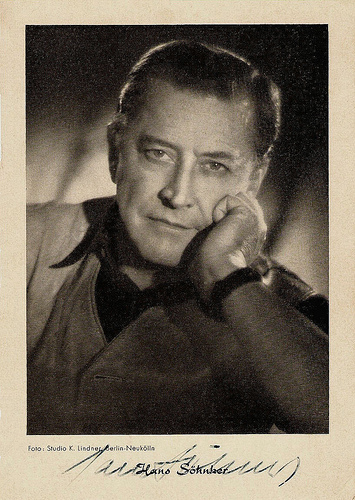
German card, mailed in 1955. Photo: Studio K. Lindner, Berlin-Neukölln.
Scene from Und du mein Schatz fährst mit! (1936). Source: Hargo 1962 (YouTube).
Sources: Filmportal.de, Thomas Staedeli (Cyranos), Wikipedia (German), and .

German postcard by Film-Foto-Verlag, no. G 188, 1941-1944. Photo: Binz, Berlin.

German postcard by Film-Foto-Verlag, no. A 3796/1, 1941-1944. Photo: Binz, Berlin.

Latvian postcard., no. 2284. Photo: J. Rolin (?), Riga. With Martha Eggerth in Der Zarewitsch/The Czarevitch (Victor Janson, 1933).
Young, Careless Lover
Hans Albert Edmund Söhnker was born in Kiel in 1903. His father was a carpenter and a book-seller, and an active member of the Social Democratic Party.
After finishing school, Hans took up an apprenticeship in a warehouse and at the same time he started taking acting lessons from Clemens Schubert and Gustaf Gründgens. In 1922, he made his stage debut at the Stadttheater Kiel, and subsequently played in theatres in Frankfurt/Oder, Danzig, Chemnitz and Bremen.
He made screen tests for the Ufa, and was finally cast by Victor Janson as Martha Eggerth 's partner in Der Zarewitsch/The Czarevitch (Victor Janson, 1933). He reprised the role of the young and careless lover for Schwarzwaldmädel/The Black Forest Girl (Georg Zoch, 1933) and Die Csardasfürstin/The Czardas Princess (Georg Jacoby, 1934).
He avoided being typecast again and instead proved his ability to play more serious characters with Arzt aus Leidenschaft/Medicine Man (Hans H. Zerlett, 1936).
His other films include Jede Frau hat ein Geheimnis/Every Woman Has A Secret (Max Obal, 1934), Eva (Johannes Riemann, 1935), Diener lassen bitten/Dinner Is Served (Hans H. Zerlett, 1936), and Truxa (Hans H. Zerlett, 1936) starring La Jana .

German postcard by Film-Foto-Verlag, no. A 3651/1, 1941-1944. Photo: Tita Binz / Ufa.

German presentation card by Film-Foto-Verlag, no. 874, series 1943/2.

German postcard by Film-Foto-Verlag, no. A 3489/1, 1941-1944. Photo: Baumann / Terra.
Natural Charm
Hans Söhnker excelled as the romantic rival of both Heinz Rühmann in Der Mustergatte/Model Husband (Wolfgang Liebeneiner, 1937) and Hans Albers in Große Freiheit Nr. 7/Great Freedom No. 7 (1944).
The latter was directed by Helmut Käutner , who frequently cast Söhnker. Käutner put Söhnker's natural charm to its best use, for instance in Frau nach Maß/Customized Woman (Helmut Käutner, 1940) based on a play by Erich Kästner.
These films made him an Ufa-star in Nazi Germany. During the Third Reich he was also on the Gestapo's black list because he often helped and hid Jews.
After the war, Söhnker, who had always continued to work as a stage actor, returned to the theatre. He re-emerged as a film actor with Film ohne Titel/Film Without Title (1947), which was produced by Käutner and directed by Rudolf Jugert.
Jugert also cast Söhnker in the comedies Hallo Fräulein/Hello Fraulein (Rudolf Jugert, 1949) and Einmaleins der Ehe/Marriage – The Basics (Rudolf Jugert, 1949).

German postcard by Film-Foto-Verlag, no. A 3952/1, 1941-1944. Photo: Foto Binz, Berlin. From Tatiana.

German postcard by Film-Foto-Verlag, no. K 1434. Photo: Tita Binz, Berlin.

German postcard by Verlag und Druckerei Erwin Preuss, Dresden-Freital, series 1, no. 20. Photo: Charlott Serda.
Elegant Presence
His dramatic performances in Nur eine Nacht/Just One Night (Fritz Kirchhoff, 1950) with Marianne Hoppe , and Weiße Schatten/White Shadows (Helmut Käutner, 1951) again proved his ability to shift effortlessly between genres.
The well aged Söhnker remained an elegant presence in the German Post-War cinema of the 1950s. Films include Die Stärkere/The Stronger Ones (Wolfgang Liebeneiner, 1953), Hoheit lassen bitten/Majesty Allow To Plea (Paul Verhoeven, 1954), and Worüber man spricht/False Shame (Wolfgang Glück, 1958).
From the 1960s on, he starred in several successful TV series like Der Forellenhof/The Trout Farm (1965), Salto Mortale (1968), and Meine Schwiegersöhne und ich/My Sons-in-law and I (1969), which sustained Söhnker's popularity up to his old age.
He also made films like Unser Haus in Kamerun/Our House in Cameroun (Alfred Vohrer, 1961), Sherlock Holmes und das Halsband des Todes/Sherlock Holmes and the Deadly Necklace (Terence Fisher, Frank Winterstein, 1962) starring Christopher Lee , Sechs Stunden Angst/Six Hours of Terror (Eugen York, 1964), and the Edgar Wallace thriller Der Hund von Blackwood Castle/The Monster of Blackwood Castle (Alfred Vohrer, 1967).
In 1973 he was awarded Germany's Bundesverdienstktreuz, and in 1977 the Filmband in Gold for his lifetime achievements. He published his memoires ...und kein Tag zuviel/And Not A Day Too Many in 1974.
Hans Söhnker passed away in Berlin in 1981. He was twice married. Actress Anneke Kim Sarnau is his great-granddaughter.

Austrian postcard by Verlag Hubmann (HDH Verlag), Wien, no. 90. Photo: Constantin-Film. Publicity still for Die Stärkere/The stronger (Wolfgang Liebeneiner, 1953).

German postcard by Ufa, no. FK 573. Photo: Grimm / Capitol / Prisma Film. Publicity still for Ein Leben für Do/A Life for Do (Gustav Ucicky, 1954).

German card, mailed in 1955. Photo: Studio K. Lindner, Berlin-Neukölln.
Scene from Und du mein Schatz fährst mit! (1936). Source: Hargo 1962 (YouTube).
Sources: Filmportal.de, Thomas Staedeli (Cyranos), Wikipedia (German), and .
Published on January 06, 2018 22:00
January 5, 2018
Michael Redgrave
Sir Michael Redgrave (1908-1985) started his film career starring in the Hitchcock classic The lady Vanishes (1938). The English stage and film actor went on to star in many British and some Hollywood productions. He was the father of film actors Vanessa, Lynn and Corin Redgrave, and the grandfather of the late Natasha Richardson, Joely Richardson, Jemma Redgrave and Carlo Nero.
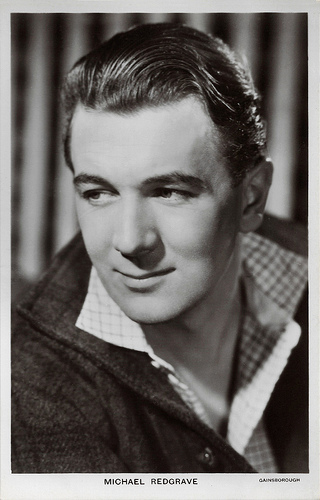
British postcard in the Picturegoer Series, London, no. 1217. Photo: Gainsborough.
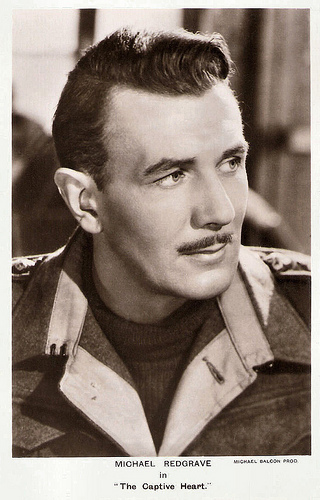
British postcard in the Picturegoer series, London, no. W 212. Photo: Michael Balcon Prod. Publicity still for The Captive Heart (Basil Dearden, 1946).
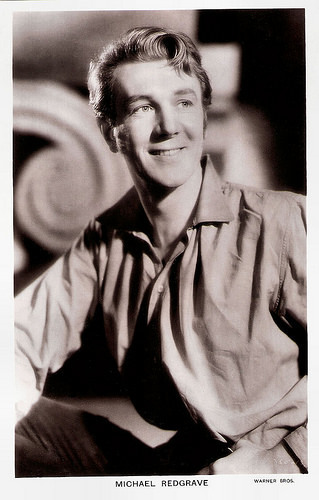
British postcard in the Picturegoer series, London, no. 1217a. Photo: Warner Bros.
The Lady Vanishes
Michael Scudamore Redgrave was born Bristol, England in 1908. He was the son of silent film actor Roy Redgrave and actress Margaret Scudamore. He never knew his father, who left when Michael was only six months old to pursue a career in Australia. His mother subsequently married Captain James Anderson, a tea planter, but Redgrave greatly disliked his stepfather.
He studied in Cambridge and tried journalism and teaching before giving acting a go. Redgrave made his first professional appearance at the Liverpool Playhouse in 1934, and spent two years with its Liverpool Repertory Company.
Here he met his future wife, actress Rachel Kempson. They married in 1935, and would have three children who would all become film actors: Vanessa Redgrave (1937), Corin Redgrave (1939-2010) and Lynn Redgrave (1943-2010).
In 1936, Tyrone Guthrie offered him a job at John Gielgud ’s famous Old Vic theatre company in London. During the 1936-1937 season he appeared in Love's Labours Lost, The Country Wife, As You Like It, The Witch of Edmonton and Hamlet as Laertes to Laurence Olivier 's Hamlet.
Michael Redgrave's first major film role was in The Lady Vanishes (Alfred Hitchcock, 1938) opposite Margaret Lockwood . His leading role as the eccentric musicologist in this huge success made him immensely popular.
Next he starred in Climbing High (Carol Reed, 1938) with Jessie Matthews , The Stars Look Down (Carol Reed, 1940) as an idealistic son of a mining family, and as an intelligent misanthrope in Thunder Rock (Roy Boulting, 1942) with James Mason .
War service put a temporary halt to his career, but even before that his involvement in the short-lived People's Convention (a Communist Party-backed anti-war movement) threatened to harm his standing. He served in the navy for a couple of years before he was invalided out with an injured arm.
The rest of the war, he spent in the theatre, though as the war drew to a close he made a film come-back as a poetic Flight-Lieutenant who is killed in The Way to the Stars (Anthony Asquith, 1945) with John Mills , and the Ealing compendium film Dead of Night (Alberto Cavalcanti a.o., 1945), in the chilling episode about a ventriloquist who thinks his dummy is out to get him.
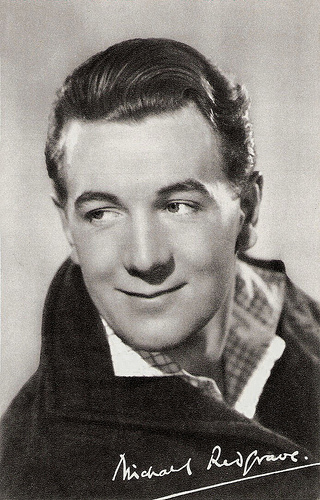
British postcard by Real Photogravure.
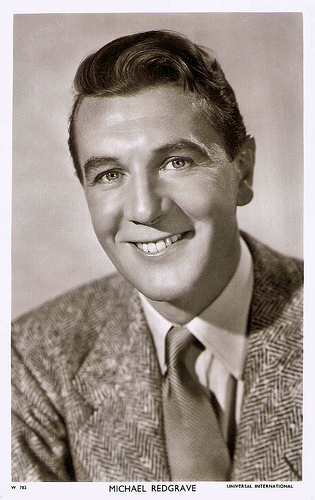
British postcard in the Picturegoer series, London, no. W 783. Photo: Universal International.
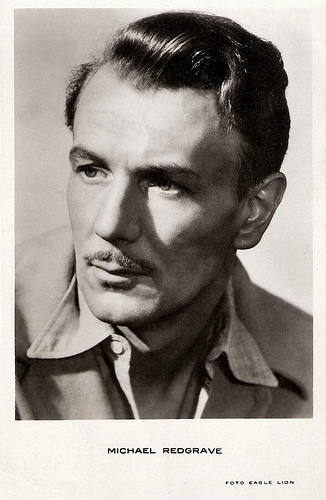
Dutch postcard. Photo: Eagle Lion.
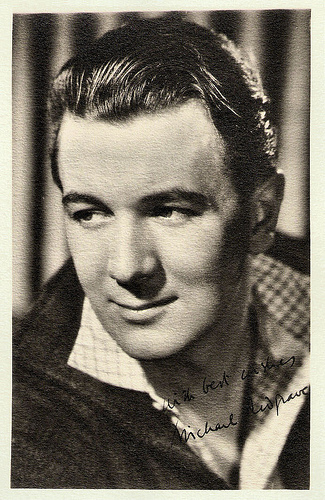
British autograph card.
The Importance of Being Earnest
For his first American film role in Mourning Becomes Electra (Dudley Nichols, 1947), Michael Redgrave was nominated for an Academy Award for Best Actor. On his return from Hollywood, he gave what is probably his finest film performance as a failed, embittered schoolmaster in The Browning Version (Anthony Asquith, 1951) opposite Jean Kent .
Redgrave also starred in The Importance of Being Earnest (Anthony Asquith, 1952), Mr. Arkadin (Orson Welles, 1955), The Dam Busters (Michael Anderson, 1955) and 1984 (Michael Anderson, 1956). He was appointed Commander of the Order of the British Empire (CBE) in 1952 and was knighted in 1959.
Throughout his career, Redgrave acted on the stage in Britain. One of his most notable roles was as the title character in Anton Chekhov's Uncle Vanya in 1962. He also excelled in Shakespearean roles.
During the 1960s he appeared in such classic films as the horror film The Innocents (Jack Clayton, 1961) starring Deborah Kerr , The Loneliness of the Long Distance Runner (Tony Richardson, 1962) with Tom Courtenay, and the war drama The Hill (Sidney Lumet, 1965) with Sean Connery .
Though his film work became less distinguished in the following decade, his theatre work continued its high standard. He toured extensively in the 1970s, until the effects of Parkinson's disease grew too great. His last film appearance was in Rime of the Ancient Mariner (Raul daSylva, 1975), based on the poem by Samuel Taylor Coleridge.
Michael Redgrave passed away in 1985 in Denham, England only one day after his 77th birthday. Until his death he was married with Rachel Kempson. Their grandchildren - Natasha and Joely Richardson, Jemma Redgrave and Carlo Nero are also film actors.
During the filming of Secret Beyond the Door... (Fritz Lang, 1947), Redgrave met Bob Michell. They became lovers. In his last autobiography he wanted to acknowledge his bisexuality, but in the end he chose to remain silent about it. Later his son Corin wrote about in Michael Redgrave: My Father (1995).
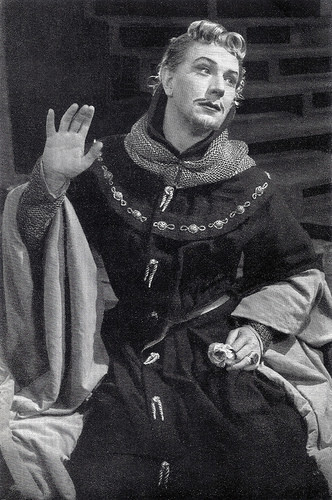
British postcard in the Shakespeare Memorial Theatre series, no. 15. Photo: Angus McBean. Michael Redgrave as King Richard II in Richard II, Stratford-upon-Avon, 1951.
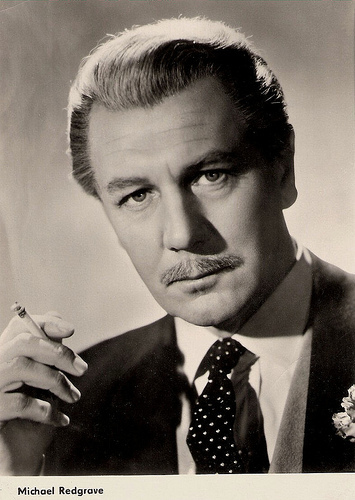
East-German postcard by VEB Progress Filmvertrieb, Berlin, no. 1445. Retail price: 0,20 DM. Publicity still for Behind the Mask (Brian Desmond Hurst, 1958).
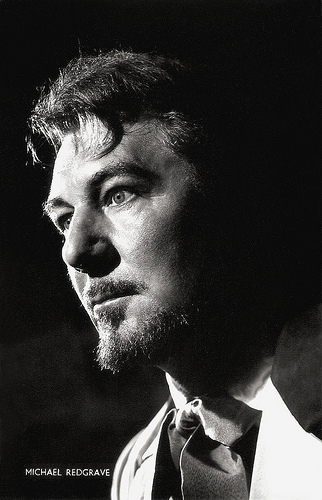
British card. Publicity still for a stage production of Uncle Vanya by Anton Chekhov in Chichester in 1963.
Sources: Brian McFarlane (Encyclopaedia of British Cinema), David Absalom (British Pictures), Britmovie, Wikipedia, and .

British postcard in the Picturegoer Series, London, no. 1217. Photo: Gainsborough.

British postcard in the Picturegoer series, London, no. W 212. Photo: Michael Balcon Prod. Publicity still for The Captive Heart (Basil Dearden, 1946).

British postcard in the Picturegoer series, London, no. 1217a. Photo: Warner Bros.
The Lady Vanishes
Michael Scudamore Redgrave was born Bristol, England in 1908. He was the son of silent film actor Roy Redgrave and actress Margaret Scudamore. He never knew his father, who left when Michael was only six months old to pursue a career in Australia. His mother subsequently married Captain James Anderson, a tea planter, but Redgrave greatly disliked his stepfather.
He studied in Cambridge and tried journalism and teaching before giving acting a go. Redgrave made his first professional appearance at the Liverpool Playhouse in 1934, and spent two years with its Liverpool Repertory Company.
Here he met his future wife, actress Rachel Kempson. They married in 1935, and would have three children who would all become film actors: Vanessa Redgrave (1937), Corin Redgrave (1939-2010) and Lynn Redgrave (1943-2010).
In 1936, Tyrone Guthrie offered him a job at John Gielgud ’s famous Old Vic theatre company in London. During the 1936-1937 season he appeared in Love's Labours Lost, The Country Wife, As You Like It, The Witch of Edmonton and Hamlet as Laertes to Laurence Olivier 's Hamlet.
Michael Redgrave's first major film role was in The Lady Vanishes (Alfred Hitchcock, 1938) opposite Margaret Lockwood . His leading role as the eccentric musicologist in this huge success made him immensely popular.
Next he starred in Climbing High (Carol Reed, 1938) with Jessie Matthews , The Stars Look Down (Carol Reed, 1940) as an idealistic son of a mining family, and as an intelligent misanthrope in Thunder Rock (Roy Boulting, 1942) with James Mason .
War service put a temporary halt to his career, but even before that his involvement in the short-lived People's Convention (a Communist Party-backed anti-war movement) threatened to harm his standing. He served in the navy for a couple of years before he was invalided out with an injured arm.
The rest of the war, he spent in the theatre, though as the war drew to a close he made a film come-back as a poetic Flight-Lieutenant who is killed in The Way to the Stars (Anthony Asquith, 1945) with John Mills , and the Ealing compendium film Dead of Night (Alberto Cavalcanti a.o., 1945), in the chilling episode about a ventriloquist who thinks his dummy is out to get him.

British postcard by Real Photogravure.

British postcard in the Picturegoer series, London, no. W 783. Photo: Universal International.

Dutch postcard. Photo: Eagle Lion.

British autograph card.
The Importance of Being Earnest
For his first American film role in Mourning Becomes Electra (Dudley Nichols, 1947), Michael Redgrave was nominated for an Academy Award for Best Actor. On his return from Hollywood, he gave what is probably his finest film performance as a failed, embittered schoolmaster in The Browning Version (Anthony Asquith, 1951) opposite Jean Kent .
Redgrave also starred in The Importance of Being Earnest (Anthony Asquith, 1952), Mr. Arkadin (Orson Welles, 1955), The Dam Busters (Michael Anderson, 1955) and 1984 (Michael Anderson, 1956). He was appointed Commander of the Order of the British Empire (CBE) in 1952 and was knighted in 1959.
Throughout his career, Redgrave acted on the stage in Britain. One of his most notable roles was as the title character in Anton Chekhov's Uncle Vanya in 1962. He also excelled in Shakespearean roles.
During the 1960s he appeared in such classic films as the horror film The Innocents (Jack Clayton, 1961) starring Deborah Kerr , The Loneliness of the Long Distance Runner (Tony Richardson, 1962) with Tom Courtenay, and the war drama The Hill (Sidney Lumet, 1965) with Sean Connery .
Though his film work became less distinguished in the following decade, his theatre work continued its high standard. He toured extensively in the 1970s, until the effects of Parkinson's disease grew too great. His last film appearance was in Rime of the Ancient Mariner (Raul daSylva, 1975), based on the poem by Samuel Taylor Coleridge.
Michael Redgrave passed away in 1985 in Denham, England only one day after his 77th birthday. Until his death he was married with Rachel Kempson. Their grandchildren - Natasha and Joely Richardson, Jemma Redgrave and Carlo Nero are also film actors.
During the filming of Secret Beyond the Door... (Fritz Lang, 1947), Redgrave met Bob Michell. They became lovers. In his last autobiography he wanted to acknowledge his bisexuality, but in the end he chose to remain silent about it. Later his son Corin wrote about in Michael Redgrave: My Father (1995).

British postcard in the Shakespeare Memorial Theatre series, no. 15. Photo: Angus McBean. Michael Redgrave as King Richard II in Richard II, Stratford-upon-Avon, 1951.

East-German postcard by VEB Progress Filmvertrieb, Berlin, no. 1445. Retail price: 0,20 DM. Publicity still for Behind the Mask (Brian Desmond Hurst, 1958).

British card. Publicity still for a stage production of Uncle Vanya by Anton Chekhov in Chichester in 1963.
Sources: Brian McFarlane (Encyclopaedia of British Cinema), David Absalom (British Pictures), Britmovie, Wikipedia, and .
Published on January 05, 2018 22:00
January 4, 2018
J. Beagles & Co
The London-based publisher J. Beagles & Co. specialised in real photo postcards. The term recognises a distinction between the real photo process and the lithographic or offset printing processes employed in the manufacture of most postcard images. Beagles's wide variety of postcards included series with stage stars and later also such series as the Famous Cinema Star series. In this post we start with the film stars and finish with the stage stars.
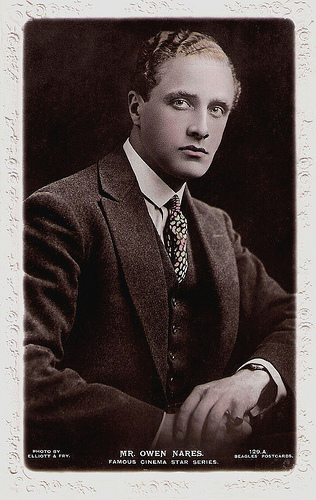
Owen Nares . British postcard in the Famous Cinema Star series by Beagles Postcards, no. 129 A. Photo: Elliott & Fry.
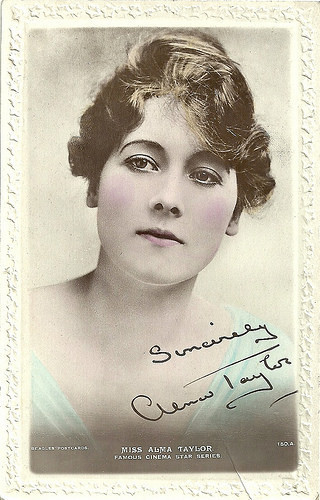
Alma Taylor . British postcard in the Famous Cinema Star series by Beagles Postcards, no. 150 A.
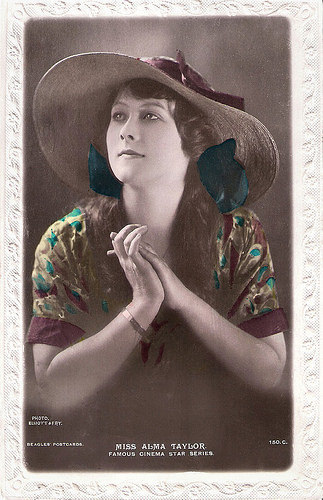
Alma Taylor . British postcard in the Famous Cinema Star series by Beagles Postcards, no. 150 C. Photo: Elliott & Fry.
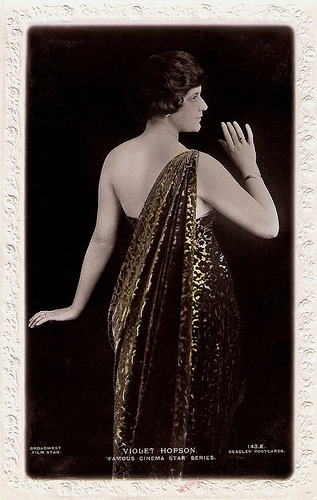
Violet Hopson . British postcard in the 'Famous Cinema Star' series' by J. Beagles & Co. Ltd., London, no. 143 E. Photo: Broadwest.
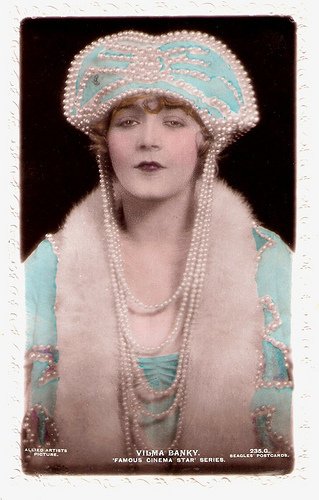
Vilma Banky . British postcard in the 'Famous Cinema Star' series by J. Beagles & Co. Ltd., London, no. 235 G. Photo: Allied Artists Pictures.
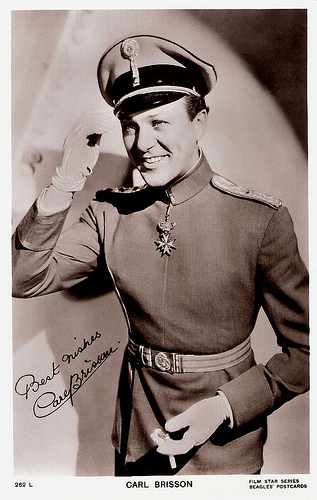
Carl Brisson . British postcard in the Film Star series by J. Beagles & Co., Ltd. London, no. 262 L.
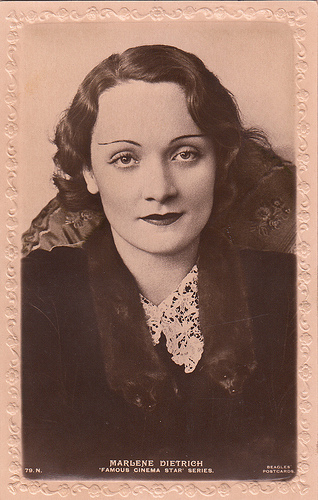
Marlene Dietrich . British postcard in the Famous Cinema Star series by Beagles Postcards, no. 79 N. Collection: Marlène Pilaete.
Beagles
John Beagles (1844-1907) was an English printer and publisher, especially of real photo postcards, through his company, J. Beagles & Co.
Beagles was born in Whaplode Drove, Lincolnshire, in 1844. His father was a 'butcher master. In 1861, John Beagles junior was recorded as a 'pupil teacher'.
In the 1891 census, Beagles was recorded as a 'photographic publisher' in Nottingham in the household of Thomas William Stevenson, printer, who would later be his executor. Later, he traded as J. Beagles & Co. from Little Britain, London, E.C.
Beagles and his successors produced a wide variety of postcards that included celebrities, stars of stage and screen, topographical and view cards in their Phototint series.
The business continued as J. Beagles & Co. Ltd. after Beagles' death.
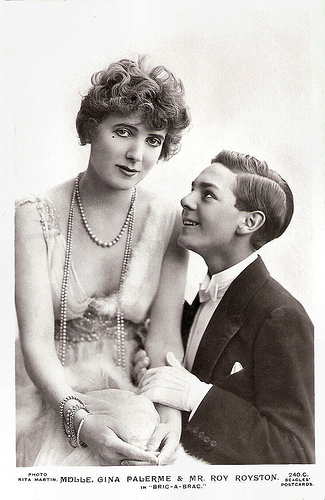
Gina Palerme and Roy Royston. British postcard by J. Beagles & Co, London, no. 240 C. Photo: Rita Martin. Publicity still for the stage production Bric-a-brac (1915).
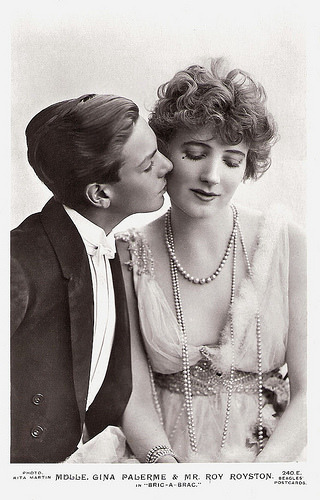
Gina Palerme and Roy Royston. British postcard by J. Beagles & Co, London, no. 240 E. Photo: Rita Martin. Publicity still for the stage production Bric-a-brac (1915).
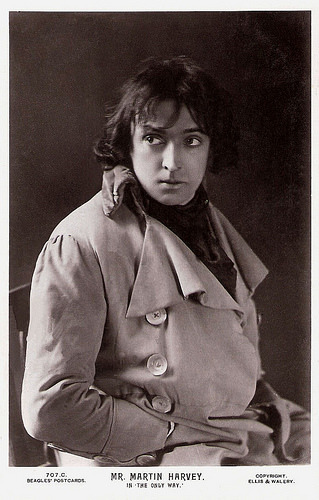
John Martin Harvey . British postcard by Beagles Postcards, no. 707 C. Photo: Ellis & Walery. Publicity still for the stage play The Only Way.
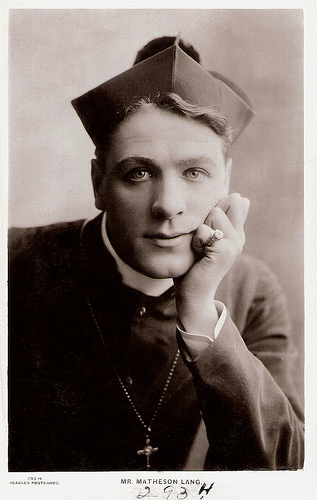
Matheson Lang . British postcard by J. Beagles & Co., London, no. 293 H.
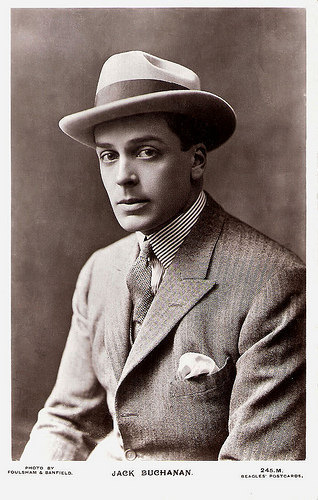
Jack Buchanan . British postcard by J. Beagles & Co., London, no. 245 M. Photo: Foulsham & Banfield.
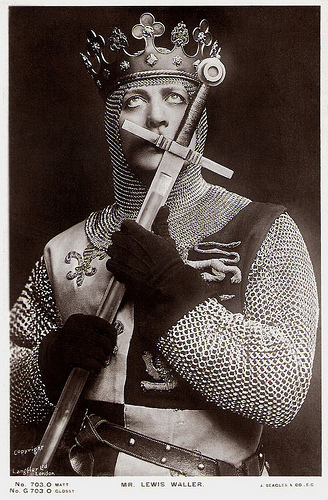
Lewis Waller . British postcard by H. Beagles & Co, E.C., no. G 703 O. Photo: Langfler Ltd.
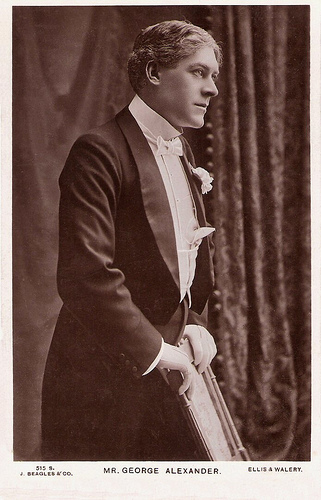
George Alexander. British postcard by J. Beagles & Co, London, no. 515 S. Photo: Ellis & Walery.
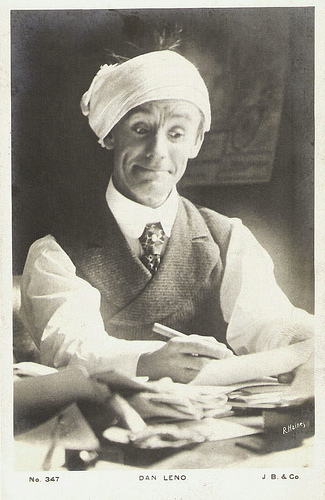
Dan Leno. British postcard by J. Beagles & Co., London, no. 347. Photo: R. Haines.
Source: Wikipedia.
It is Postcard Friendship Friday, hosted by Beth at the The Best Hearts are Crunchy. You can visit her by clicking on the button below.


Owen Nares . British postcard in the Famous Cinema Star series by Beagles Postcards, no. 129 A. Photo: Elliott & Fry.

Alma Taylor . British postcard in the Famous Cinema Star series by Beagles Postcards, no. 150 A.

Alma Taylor . British postcard in the Famous Cinema Star series by Beagles Postcards, no. 150 C. Photo: Elliott & Fry.

Violet Hopson . British postcard in the 'Famous Cinema Star' series' by J. Beagles & Co. Ltd., London, no. 143 E. Photo: Broadwest.

Vilma Banky . British postcard in the 'Famous Cinema Star' series by J. Beagles & Co. Ltd., London, no. 235 G. Photo: Allied Artists Pictures.

Carl Brisson . British postcard in the Film Star series by J. Beagles & Co., Ltd. London, no. 262 L.

Marlene Dietrich . British postcard in the Famous Cinema Star series by Beagles Postcards, no. 79 N. Collection: Marlène Pilaete.
Beagles
John Beagles (1844-1907) was an English printer and publisher, especially of real photo postcards, through his company, J. Beagles & Co.
Beagles was born in Whaplode Drove, Lincolnshire, in 1844. His father was a 'butcher master. In 1861, John Beagles junior was recorded as a 'pupil teacher'.
In the 1891 census, Beagles was recorded as a 'photographic publisher' in Nottingham in the household of Thomas William Stevenson, printer, who would later be his executor. Later, he traded as J. Beagles & Co. from Little Britain, London, E.C.
Beagles and his successors produced a wide variety of postcards that included celebrities, stars of stage and screen, topographical and view cards in their Phototint series.
The business continued as J. Beagles & Co. Ltd. after Beagles' death.

Gina Palerme and Roy Royston. British postcard by J. Beagles & Co, London, no. 240 C. Photo: Rita Martin. Publicity still for the stage production Bric-a-brac (1915).

Gina Palerme and Roy Royston. British postcard by J. Beagles & Co, London, no. 240 E. Photo: Rita Martin. Publicity still for the stage production Bric-a-brac (1915).

John Martin Harvey . British postcard by Beagles Postcards, no. 707 C. Photo: Ellis & Walery. Publicity still for the stage play The Only Way.

Matheson Lang . British postcard by J. Beagles & Co., London, no. 293 H.

Jack Buchanan . British postcard by J. Beagles & Co., London, no. 245 M. Photo: Foulsham & Banfield.

Lewis Waller . British postcard by H. Beagles & Co, E.C., no. G 703 O. Photo: Langfler Ltd.

George Alexander. British postcard by J. Beagles & Co, London, no. 515 S. Photo: Ellis & Walery.

Dan Leno. British postcard by J. Beagles & Co., London, no. 347. Photo: R. Haines.
Source: Wikipedia.
It is Postcard Friendship Friday, hosted by Beth at the The Best Hearts are Crunchy. You can visit her by clicking on the button below.

Published on January 04, 2018 22:00
January 3, 2018
Monika Vogelsang (1920)
Henny Porten and the young and handsome Paul Hartmann were the stars of the Messter film drama Monika Vogelsang (Rudolf Biebrach, 1920).
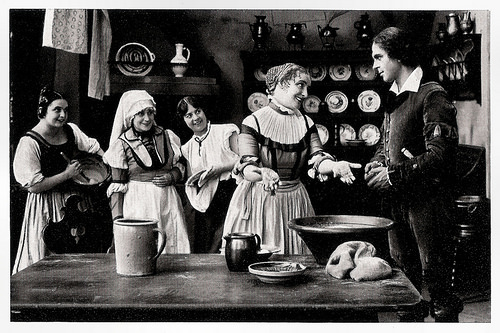
German collectors card by Ross Verlag in the series Vom Werden deutscher Filmkunst - Der Stumme Film, picture, picture no. 81, group 43. Photo: Ufa. Publicity still for Monika Vogelsang (Rudolf Biebrach, 1920) with Henny Porten and Paul Hartmann .
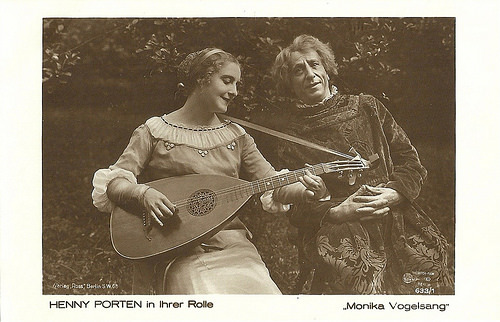
German postcard by Ross Verlag, no. 633/1. Photo: Messter Film, Berlin. Publicity still still of Henny Porten and Gustav Botz [?] in Monika Vogelsang (Rudolf Biebrach, 1920).
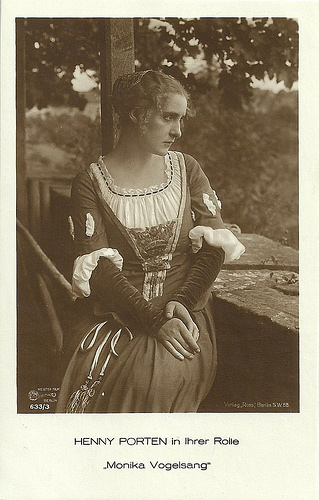
German postcard by Ross Verlag, no. 633/3. Photo: Messter Film, Berlin. Publicity still still of Henny Porten in Monika Vogelsang (Rudolf Biebrach, 1920).
A masterpiece of character representation
One day, Monica Vogelsang ( Henny Porten ), daughter of the reputed counsellor Jacobus Vogelsang (Gustav Botz), meets the visiting painter Amadeo Vaselli ( Paul Hartmann ) and immediately falls in love with him.
But Amadeo is rivalled by the idle Johannes (Ernst Deutsch), working for Vogelsang, and eyeing young Monica for some time. When he is rejected by Monika he avenges himself by gossipping about her, making evil remarks and hints. He tries to eliminate his opponent, but in a fight Amadeo stabs John.
Amadeo is arrested and admits his deed. To save his neck, Monica claims that Amadeo had been with her the questionable night, but Amadeo sticks to his confession and is condemned to death by the rope. His last wish to just see Monica once more is granted. So shortly before his execution, Monica faces him one last time, while covered in a veil.
Monica breaks down. When the veil is lifted, one notices her hair has become white. After Amadeo's execution, Monica erects a chapel in his honour. She descends to his grave and slides down to the ground, mentally crushed. Later, Amadeo is rehabilitated by the Archbishop (Wilhelm Diegelmann).
Monika Vogelsang, based on the novel by Felix Philippi and scripted by Hans Kräly, was shot in 1919 but premiered on 2 January 1920 in Berlin. Exteriors were shot in Rothenburg ob der Tauber, Bavaria, Germany. Sets were designed by Kurt Dürnhöfer.
Oskar Kalbus in Vom Werden deutscher Filmkunst. 1. Der stumme Film (Berlin, 1935): "With this film, we are transferred to the heroic period of the Renaissance with its passions that extend into the bourgeoisie. A masterpiece of character representation was how Henny Porten 's meek-naive childishness develops into active heroism."
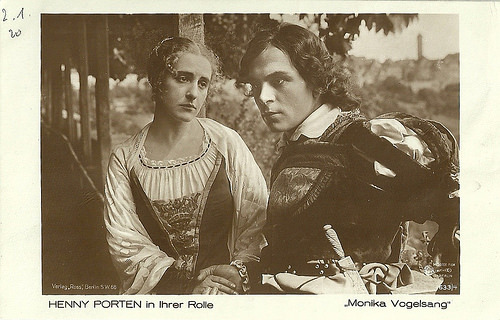
German postcard by Ross Verlag, no. 633/4. Photo: Messter Film, Berlin. Publicity still still of Henny Porten and Paul Hartmann in Monika Vogelsang (Rudolf Biebrach, 1920).
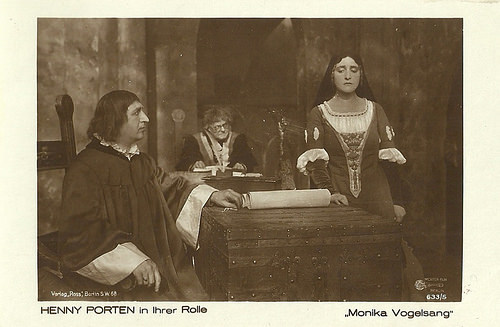
German postcard by Ross Verlag, no. 633/5. Photo: Messter Film, Berlin. Publicity still still of Henny Porten in Monika Vogelsang (Rudolf Biebrach, 1920).
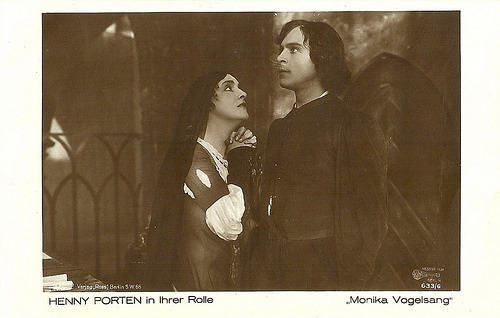
German postcard by Ross Verlag, no. 633/6. Photo: Messter Film, Berlin. Publicity still still of Henny Porten and Paul Hartmann in Monika Vogelsang (Rudolf Biebrach, 1920).
Sources: Wikipedia (German) and IMDb.

German collectors card by Ross Verlag in the series Vom Werden deutscher Filmkunst - Der Stumme Film, picture, picture no. 81, group 43. Photo: Ufa. Publicity still for Monika Vogelsang (Rudolf Biebrach, 1920) with Henny Porten and Paul Hartmann .

German postcard by Ross Verlag, no. 633/1. Photo: Messter Film, Berlin. Publicity still still of Henny Porten and Gustav Botz [?] in Monika Vogelsang (Rudolf Biebrach, 1920).

German postcard by Ross Verlag, no. 633/3. Photo: Messter Film, Berlin. Publicity still still of Henny Porten in Monika Vogelsang (Rudolf Biebrach, 1920).
A masterpiece of character representation
One day, Monica Vogelsang ( Henny Porten ), daughter of the reputed counsellor Jacobus Vogelsang (Gustav Botz), meets the visiting painter Amadeo Vaselli ( Paul Hartmann ) and immediately falls in love with him.
But Amadeo is rivalled by the idle Johannes (Ernst Deutsch), working for Vogelsang, and eyeing young Monica for some time. When he is rejected by Monika he avenges himself by gossipping about her, making evil remarks and hints. He tries to eliminate his opponent, but in a fight Amadeo stabs John.
Amadeo is arrested and admits his deed. To save his neck, Monica claims that Amadeo had been with her the questionable night, but Amadeo sticks to his confession and is condemned to death by the rope. His last wish to just see Monica once more is granted. So shortly before his execution, Monica faces him one last time, while covered in a veil.
Monica breaks down. When the veil is lifted, one notices her hair has become white. After Amadeo's execution, Monica erects a chapel in his honour. She descends to his grave and slides down to the ground, mentally crushed. Later, Amadeo is rehabilitated by the Archbishop (Wilhelm Diegelmann).
Monika Vogelsang, based on the novel by Felix Philippi and scripted by Hans Kräly, was shot in 1919 but premiered on 2 January 1920 in Berlin. Exteriors were shot in Rothenburg ob der Tauber, Bavaria, Germany. Sets were designed by Kurt Dürnhöfer.
Oskar Kalbus in Vom Werden deutscher Filmkunst. 1. Der stumme Film (Berlin, 1935): "With this film, we are transferred to the heroic period of the Renaissance with its passions that extend into the bourgeoisie. A masterpiece of character representation was how Henny Porten 's meek-naive childishness develops into active heroism."

German postcard by Ross Verlag, no. 633/4. Photo: Messter Film, Berlin. Publicity still still of Henny Porten and Paul Hartmann in Monika Vogelsang (Rudolf Biebrach, 1920).

German postcard by Ross Verlag, no. 633/5. Photo: Messter Film, Berlin. Publicity still still of Henny Porten in Monika Vogelsang (Rudolf Biebrach, 1920).

German postcard by Ross Verlag, no. 633/6. Photo: Messter Film, Berlin. Publicity still still of Henny Porten and Paul Hartmann in Monika Vogelsang (Rudolf Biebrach, 1920).
Sources: Wikipedia (German) and IMDb.
Published on January 03, 2018 22:00
January 2, 2018
Marianne Simson
German dancer and film actress Marianne Simson (1920-1992) appeared in 18 films between 1935 and 1945. Her film career took off during WW II. The sporty, beautiful blonde was cast in both musicals, historical adventures and dramas. Because of informing the Gestapo during the war, she was arrested after the war and sentenced to prison. After her release, she became a choreographer.
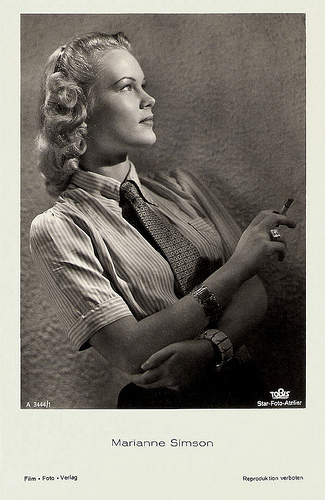
German postcard by Film-Foto-Verlag, no. A 3444/1, 1941-1944. Photo: Star-Foto-Atelier / Tobis.
Nazi propaganda
Marianne Lena Elisabeth Clara Simson was born in Berlin in 1920. She was the daughter of an insurance clerk, John Edward Simson and his wife Frida née Kühl. Her brother was Helmut Simson, who after the war served as mayor of Wolfsburg.
She received an education in classical dance from Victor Gsovsky and in 1935, the young Simson became a dancer at the Nollendorftheater in Berlin. In 1936 she became a dancer at the Deutsche Opernhaus in Berlin and in 1939 at the Staatstheater under Gustaf Gründgens.
At the time, Marianne Simson was quite renowned as a ballerina, for example in 1941 a porcelain figurine was produced, depicting her on her toes. The figurine was reproduced in around 1957 by the company Rosenthal, and bears her name underneath.
As a teenager, Simson already made her screen debut in a supporting part in Friesennot/Frisians in Distress (Peter Hagen, 1935), made for Nazi propaganda purposes. The film drama concerns a Russian village of ethnic Frisians for whom the Soviet authorities make life as difficult as possible. After the Molotov–Ribbentrop Pact, in 1939, the film was banned. In 1941, after the invasion of Russia, it was again reissued under a new title.
After her first film appearance, Simson went on to play in another fifteen films over the next decade, generally in supporting roles. Three years after her debut, she appeared in the comedy Das Verlegenheitskind/The embarrassment child (Peter Paul Brauer, 1938) with Ida Wüst .
In 1939, she played in three films, the adventure Mann für Mann/Man for Man (Robert A. Stemmle, 1939) with Gisela Uhlen , Zentrale Rio/Central Río (Erich Engels, 1939) and the Fairy-tale Schneewittchen und die sieben Zwerge/Snowwhite and the Seven Dwarfs (Carl Heinz Wolff, 1939) in which she starred as Snowwhite. The following year, she had another leading role in the comedy Zwei Welten/Two Worlds (Gustaf Gründgens, 1940) with Antje Weisgerber and Joachim Brennecke .
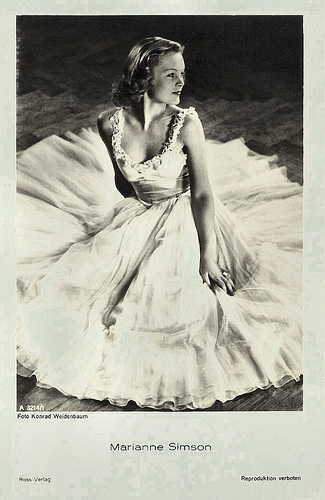
German postcard by Ross Verlag, no. A 3214/1, 1941-1944. Photo: Konrad Weidenbaum.
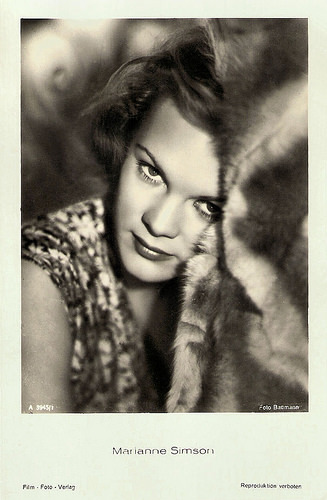
German postcard by Film-Foto-Verlag, no. A 3945/1, 1941-1944. Photo: Baumann.
Joseph Goebbels's lover
Marianne Simson’s film career took off during WW II. In 1941, she appeared in a supporting part in the musical Die schwedische Nachtigall/The Swedish Nightingale (Peter Paul Brauer, 1941), starring Ilse Werner and Joachim Gottschalk . It portrays a romance between the writer Hans Christian Andersen and the opera singer Jenny Lind, the ‘Swedish Nightingale’ of the title.
Simson played the second female lead romantic comedy Zwei in einer großen Stadt/Two in a Big City (Volker von Collande, 1942), starring Claude Farell and Karl John. John played a German soldier on leave in Berlin, who goes looking for his pen pal who he has never met called Gisela.
Simson then appeared in the historical drama Andreas Schlüter (Herbert Maisch, 1942), about the life of the eighteenth century German architect Andreas Schlüter portrayed by Heinrich George . Her next film, the comedy Das Bad auf der Tenne/The Bath in the Barn (Volker von Collande, 1943) was shot in Agfacolor, one of only a few German films made in colour during the war years.
Another example was the fantasy Münchhausen (Josef von Báky, 1943), featuring Hans Albers , in which Simson played the woman in the moon, maybe her best known part.
She then played one of the daughters of Henny Porten and Paul Westermeier in the family chronicle Familie Buchholz/The Buchholz Family (Carl Froelich, 1944) and the direct sequel Neigungsehe/Marriage of Affection (Carl Froelich, 1944), both set Berlin.
In 1943, Marianne Simson filed an application for membership in the NSDAP, which was rejected. In July 1944 she informed on Fritz Goes, an army major, to the Gestapo for allegedly making comments that were supportive of the 20 July plot to assassinate Adolf Hitler. Goes was subsequently imprisoned and tortured by the Gestapo for three months.
In the interrogation by the SS Obersturmbannführer Karl Radl (adjutant of Otto Skorzeny) and in the court hearing before a special court of the army, Simson maintained her testimony, which however was judged as unbelievable: statements by Viktor de Kowa , Anneliese Uhlig , the film producer Herbert Engelsing and General Jesco von Puttkamer provided for the acquittal of the defendant.
By that time she was rumoured to be Dr. Joseph Goebbels's lover and she complained to him about her denunciation. Following the defeat of Germany, Simson and her parents were arrested by the NKVD, the leading Soviet secret police organisation, and she was placed in a series of detention camps. There she was active in organising performances and giving song recitals.
In 1950 she was sentenced to eight years in prison, but was given an early release in 1952 and moved to West Germany. She played in a few TV films, and later worked as a choreographer in some stage productions. She married the theatre director Wilhelm List Diehl.
Marianne Simson passed away in 1992 in Füssen, Germany. She was 71.
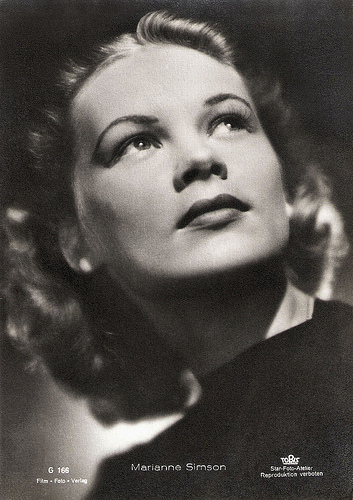
German postcard by Film-Foto-Verlag, no. G 166, 1941-1944. Photo: Star-Foto-Atelier / Tobis.
Sources: Stephanie D’heil (Steffi-Line), (IMDb), Wikipedia (German and English), and .

German postcard by Film-Foto-Verlag, no. A 3444/1, 1941-1944. Photo: Star-Foto-Atelier / Tobis.
Nazi propaganda
Marianne Lena Elisabeth Clara Simson was born in Berlin in 1920. She was the daughter of an insurance clerk, John Edward Simson and his wife Frida née Kühl. Her brother was Helmut Simson, who after the war served as mayor of Wolfsburg.
She received an education in classical dance from Victor Gsovsky and in 1935, the young Simson became a dancer at the Nollendorftheater in Berlin. In 1936 she became a dancer at the Deutsche Opernhaus in Berlin and in 1939 at the Staatstheater under Gustaf Gründgens.
At the time, Marianne Simson was quite renowned as a ballerina, for example in 1941 a porcelain figurine was produced, depicting her on her toes. The figurine was reproduced in around 1957 by the company Rosenthal, and bears her name underneath.
As a teenager, Simson already made her screen debut in a supporting part in Friesennot/Frisians in Distress (Peter Hagen, 1935), made for Nazi propaganda purposes. The film drama concerns a Russian village of ethnic Frisians for whom the Soviet authorities make life as difficult as possible. After the Molotov–Ribbentrop Pact, in 1939, the film was banned. In 1941, after the invasion of Russia, it was again reissued under a new title.
After her first film appearance, Simson went on to play in another fifteen films over the next decade, generally in supporting roles. Three years after her debut, she appeared in the comedy Das Verlegenheitskind/The embarrassment child (Peter Paul Brauer, 1938) with Ida Wüst .
In 1939, she played in three films, the adventure Mann für Mann/Man for Man (Robert A. Stemmle, 1939) with Gisela Uhlen , Zentrale Rio/Central Río (Erich Engels, 1939) and the Fairy-tale Schneewittchen und die sieben Zwerge/Snowwhite and the Seven Dwarfs (Carl Heinz Wolff, 1939) in which she starred as Snowwhite. The following year, she had another leading role in the comedy Zwei Welten/Two Worlds (Gustaf Gründgens, 1940) with Antje Weisgerber and Joachim Brennecke .

German postcard by Ross Verlag, no. A 3214/1, 1941-1944. Photo: Konrad Weidenbaum.

German postcard by Film-Foto-Verlag, no. A 3945/1, 1941-1944. Photo: Baumann.
Joseph Goebbels's lover
Marianne Simson’s film career took off during WW II. In 1941, she appeared in a supporting part in the musical Die schwedische Nachtigall/The Swedish Nightingale (Peter Paul Brauer, 1941), starring Ilse Werner and Joachim Gottschalk . It portrays a romance between the writer Hans Christian Andersen and the opera singer Jenny Lind, the ‘Swedish Nightingale’ of the title.
Simson played the second female lead romantic comedy Zwei in einer großen Stadt/Two in a Big City (Volker von Collande, 1942), starring Claude Farell and Karl John. John played a German soldier on leave in Berlin, who goes looking for his pen pal who he has never met called Gisela.
Simson then appeared in the historical drama Andreas Schlüter (Herbert Maisch, 1942), about the life of the eighteenth century German architect Andreas Schlüter portrayed by Heinrich George . Her next film, the comedy Das Bad auf der Tenne/The Bath in the Barn (Volker von Collande, 1943) was shot in Agfacolor, one of only a few German films made in colour during the war years.
Another example was the fantasy Münchhausen (Josef von Báky, 1943), featuring Hans Albers , in which Simson played the woman in the moon, maybe her best known part.
She then played one of the daughters of Henny Porten and Paul Westermeier in the family chronicle Familie Buchholz/The Buchholz Family (Carl Froelich, 1944) and the direct sequel Neigungsehe/Marriage of Affection (Carl Froelich, 1944), both set Berlin.
In 1943, Marianne Simson filed an application for membership in the NSDAP, which was rejected. In July 1944 she informed on Fritz Goes, an army major, to the Gestapo for allegedly making comments that were supportive of the 20 July plot to assassinate Adolf Hitler. Goes was subsequently imprisoned and tortured by the Gestapo for three months.
In the interrogation by the SS Obersturmbannführer Karl Radl (adjutant of Otto Skorzeny) and in the court hearing before a special court of the army, Simson maintained her testimony, which however was judged as unbelievable: statements by Viktor de Kowa , Anneliese Uhlig , the film producer Herbert Engelsing and General Jesco von Puttkamer provided for the acquittal of the defendant.
By that time she was rumoured to be Dr. Joseph Goebbels's lover and she complained to him about her denunciation. Following the defeat of Germany, Simson and her parents were arrested by the NKVD, the leading Soviet secret police organisation, and she was placed in a series of detention camps. There she was active in organising performances and giving song recitals.
In 1950 she was sentenced to eight years in prison, but was given an early release in 1952 and moved to West Germany. She played in a few TV films, and later worked as a choreographer in some stage productions. She married the theatre director Wilhelm List Diehl.
Marianne Simson passed away in 1992 in Füssen, Germany. She was 71.

German postcard by Film-Foto-Verlag, no. G 166, 1941-1944. Photo: Star-Foto-Atelier / Tobis.
Sources: Stephanie D’heil (Steffi-Line), (IMDb), Wikipedia (German and English), and .
Published on January 02, 2018 22:00
January 1, 2018
Jana Brejchová
Alluring Czech film actress Jana Brejchová (1940) appeared in more than 70 films since her debut in 1953 at the age of 13. The beautiful blonde actress was married to director Miloš Forman. She worked with such noted directors as Vojtěch Jasný, Oldrich Lipsky and Jiri Weiss, and her films often entered the major European festivals.
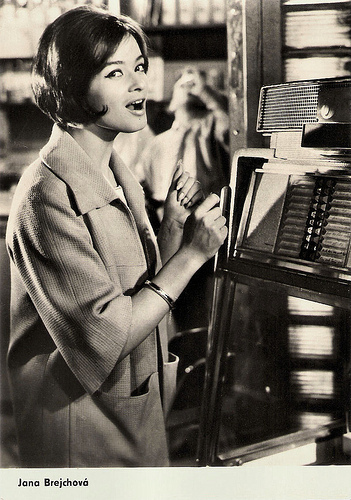
East-German postcard by VEB Progress Film-Vertrieb, no. 1565, 1961. Photo: DEFA/Pathenheimer. Publicity still for Der Traum des Hauptmann Loy/The dream of Captain Loy (Kurt Maetzig, 1961).
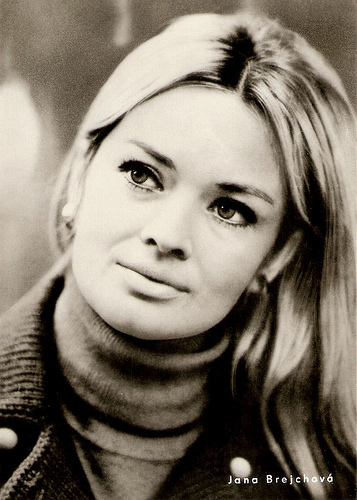
East-German postcard by VEB Progress Film-Vertrieb, no. 27/71.
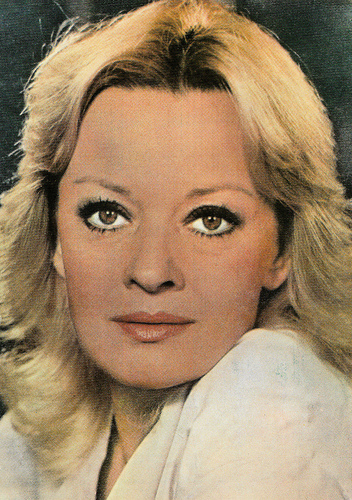
Romanian postcard by Casa Filmului Acin, no. 43078.
Jana and Hana
Jana Brejchová was born in 1940 in Prague, Protectorate Bohemia and Moravia (now Czech Republic). Her younger sister Hana Brejchová (1946) is also an actress who appeared in the Miloš Forman films Lásky jedné plavovlásky/Loves of a Blonde (1965) and Amadeus (1984).
Jana made her film debut at the age of 13 in Olověný chléb/Lead bread (Jirí Sequens, 1953). One of Jana’s next films was Žižkovská romance/A Local Romance (Zbyněk Brynych, 1958) with Hanus Bor. It was entered into the 1958 Cannes Film Festival. Her next film, Touha/Desire (Vojtěch Jasný, 1958), was entered into the 1959 Cannes Film Festival.
Another success was Vlcí jáma/Wolf Trap (Jiri Weiss, 1958). The film established director Jiri Weiss as one of the major figures of Czechoslovakia's emerging film industry in the post-war era. It won Weiss the FIPRESCI award at the Venice Film Festival, and the film itself was nominee for the Golden Bear.
She played a student in the Czech drama Vyšší princip/Higher Principle (Jirí Krejcík, 1960) based on a short story from the book Silent Barricade by Jan Drda. The story, taking place during the Nazi occupation, is about relationship between students and their elderly teacher of Latin (František Smolík) nicknamed Higher Principle for his frequent quotation of Seneca's moral precepts.
After three of their classmates are killed by Nazis during the murderous hysteria following the assassination of general Heydrich (just because they made fun of Heydrich), the teacher risks his own life but gains the respect of all students declaring that from the standpoint of higher principles the killing of a tyrant is not a crime! The film was temporally banned in West Germany as being an ‘anti-German film’.
Also interesting was Jirí Krejcík’s earlier film Morálka paní Dulské/The Morals of Mrs. Dulski (1958).

East-German postcard by VEB Progress Film-Vertrieb, no. 1011, 1959. Photo: publicity still for Touha/Desire (Vojtech Jasný, 1958).
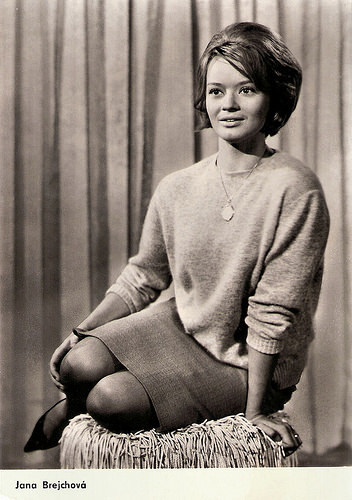
East-German postcard by VEB Progress Film-Vertrieb, no. 1409, 1961. Photo: Kurt Wunsch.
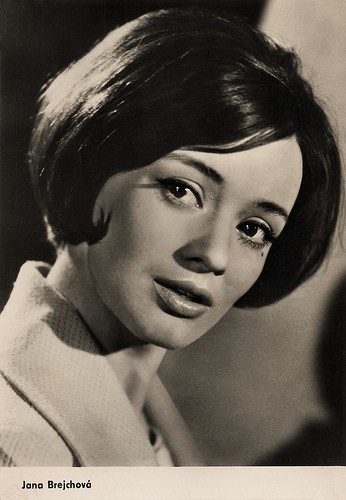
East-German postcard by VEB Progress Film-Vertrieb, no. 1573/1961. Photo: DEFA / Pathenheimer. Publicity still for Der Traum des Hauptmann Loy/The dream of Captain Loy (Kurt Maetzig, 1961).
An atomic bomb blast that causes women to grow beards
Jana Brejchová played Princess Bianca in the Czechoslovak romantic adventure film Baron Prášil/The Fabulous Baron Munchausen (Karel Zeman, 1961), based on the tales about the outrageous Baron Munchausen (Miloš Kopecký). The film combines live-action with various forms of animation and is highly stylised, often evoking the engravings of Gustave Doré.
In East-Germany, she played in the thriller Der Traum des Hauptmann Loy/The dream of Captain Loy (Kurt Maetzig, 1961) with Horst Drinda and Ulrich Thein . The latter would become her second husband.
In West-Germany, she starred in the romantic comedy Schloß Gripsholm/The Gripsholm Castle (Kurt Hoffmann, 1963) with Walter Giller , ans also appeared in Hoffmann’s drama Das Haus in der Karpfengasse/The House in Karp Lane (Kurt Hoffmann, 1965), which was filmed in Prague.
The following year, she played again opposite Walter Giller in Dýmky/The Pipes (Vojtěch Jasný, 1966). The film, also starring Gitte Haenning , was entered into the 1966 Cannes Film Festival.
Jana Brejchová starred in Noc nevesty/The Nun's Night (Karel Kachyna, 1967) as a former nun who starts to run her father’s farm. Then followed the comedy Farářův konec/End of a Priest (Evald Schorm, 1969) with her then husband Vlastimil Brodský. With Brodsky, she also co-starred in the Czechoslovak musical Noc na Karlštejně/A Night at Karlstein (Zdeněk Podskalský, 1974), based on an 1884 play by Jaroslav Vrchlický.
Oldrich Lipsky directed her in the Science-Fiction comedy Zabil jsem Einsteina, panove/ I Killed Einstein, Gentlemen (1970) about an atomic bomb blast that causes women to grow beards and lose the ability to have children. The decision is made to travel back in time and to murder Albert Einstein so that the atomic bomb never gets invented.
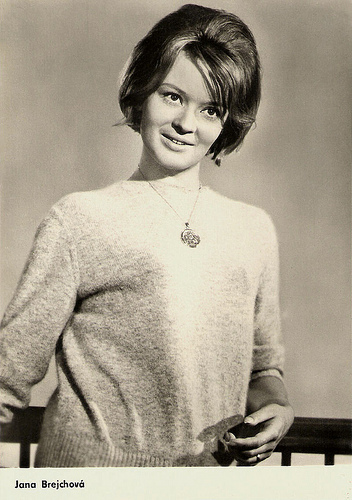
East-German postcard by VEB Progress Film-Vertrieb, no. 1740, 1962. Photo: Kurt Wunsch.
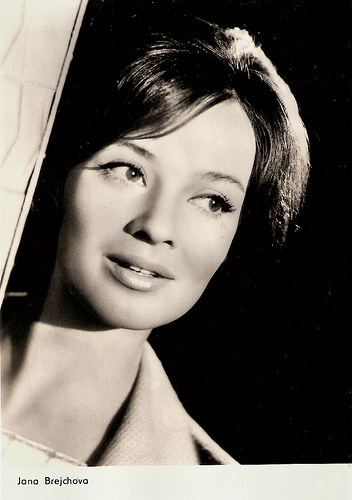
East-German postcard by VEB Progress Film-Vertrieb, no. 2294, 1965. Photo: DEFA / Pathenheimer.
The Czech Oscar
Since the 1970s, Jana Brejchová also works as a theatre actress.
Her later films include the Gothic fairytale Panna a netvor/Beauty and the Beast (Juraj Herz, 1978), Mladý muž a bílá velryba/The Young Man and Moby Dick (Jaromil Jireš, 1979), Zánik samoty Berhof/End of the Lonely Farm Berghof (Jiří Svoboda, 1984), the drama Skalpel, prosím/Scalpel, Please (Jiří Svoboda, 1985), and the drama Početí mého mladšího bratra/The Conception of My Younger Brother (Vladimír Drha, 2000) with Dana Vávrová.
More recently, she played a supporting part in the tragicomedy Kráska v nesnázích/Beauty in Trouble (Jan Hřebejk, 2006). For her part in this film, she won the Czech Oscar, the Český lev (the Czech Lion).
In 2009, she won another Český lev for her ‘longstanding artistic contribution to Czech film’.
Jana Brejchová has been married four times. Her husbands were director Milos Forman (1958-1962), East-German actor Ulrich Thein (1964-1965), actor Vlastimil Brodský (1966-1983), and actor Jirí Zahajský (1997-2007 – his death). With Vlastimil Brodsky, she has a daughter, Tereza Brodska, who is now also a successful actress.

East-German postcard by VEB Progress Film-Vertrieb, no. 1.962, 1964. Photo: Ceskolovensky Filmexport, Praha.
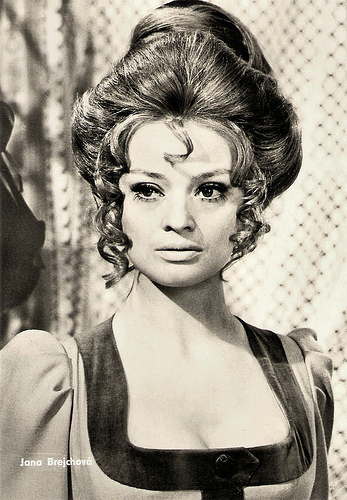
East-German postcard by VEB Progress Film-Vertrieb, no. 57/71. Photo: publicity still for Luk královny Dorotky/Queen Dorothy's Bow (Jan Schmidt, 1971).
Sources: Wikipedia (Czech and English), and .

East-German postcard by VEB Progress Film-Vertrieb, no. 1565, 1961. Photo: DEFA/Pathenheimer. Publicity still for Der Traum des Hauptmann Loy/The dream of Captain Loy (Kurt Maetzig, 1961).

East-German postcard by VEB Progress Film-Vertrieb, no. 27/71.

Romanian postcard by Casa Filmului Acin, no. 43078.
Jana and Hana
Jana Brejchová was born in 1940 in Prague, Protectorate Bohemia and Moravia (now Czech Republic). Her younger sister Hana Brejchová (1946) is also an actress who appeared in the Miloš Forman films Lásky jedné plavovlásky/Loves of a Blonde (1965) and Amadeus (1984).
Jana made her film debut at the age of 13 in Olověný chléb/Lead bread (Jirí Sequens, 1953). One of Jana’s next films was Žižkovská romance/A Local Romance (Zbyněk Brynych, 1958) with Hanus Bor. It was entered into the 1958 Cannes Film Festival. Her next film, Touha/Desire (Vojtěch Jasný, 1958), was entered into the 1959 Cannes Film Festival.
Another success was Vlcí jáma/Wolf Trap (Jiri Weiss, 1958). The film established director Jiri Weiss as one of the major figures of Czechoslovakia's emerging film industry in the post-war era. It won Weiss the FIPRESCI award at the Venice Film Festival, and the film itself was nominee for the Golden Bear.
She played a student in the Czech drama Vyšší princip/Higher Principle (Jirí Krejcík, 1960) based on a short story from the book Silent Barricade by Jan Drda. The story, taking place during the Nazi occupation, is about relationship between students and their elderly teacher of Latin (František Smolík) nicknamed Higher Principle for his frequent quotation of Seneca's moral precepts.
After three of their classmates are killed by Nazis during the murderous hysteria following the assassination of general Heydrich (just because they made fun of Heydrich), the teacher risks his own life but gains the respect of all students declaring that from the standpoint of higher principles the killing of a tyrant is not a crime! The film was temporally banned in West Germany as being an ‘anti-German film’.
Also interesting was Jirí Krejcík’s earlier film Morálka paní Dulské/The Morals of Mrs. Dulski (1958).

East-German postcard by VEB Progress Film-Vertrieb, no. 1011, 1959. Photo: publicity still for Touha/Desire (Vojtech Jasný, 1958).

East-German postcard by VEB Progress Film-Vertrieb, no. 1409, 1961. Photo: Kurt Wunsch.

East-German postcard by VEB Progress Film-Vertrieb, no. 1573/1961. Photo: DEFA / Pathenheimer. Publicity still for Der Traum des Hauptmann Loy/The dream of Captain Loy (Kurt Maetzig, 1961).
An atomic bomb blast that causes women to grow beards
Jana Brejchová played Princess Bianca in the Czechoslovak romantic adventure film Baron Prášil/The Fabulous Baron Munchausen (Karel Zeman, 1961), based on the tales about the outrageous Baron Munchausen (Miloš Kopecký). The film combines live-action with various forms of animation and is highly stylised, often evoking the engravings of Gustave Doré.
In East-Germany, she played in the thriller Der Traum des Hauptmann Loy/The dream of Captain Loy (Kurt Maetzig, 1961) with Horst Drinda and Ulrich Thein . The latter would become her second husband.
In West-Germany, she starred in the romantic comedy Schloß Gripsholm/The Gripsholm Castle (Kurt Hoffmann, 1963) with Walter Giller , ans also appeared in Hoffmann’s drama Das Haus in der Karpfengasse/The House in Karp Lane (Kurt Hoffmann, 1965), which was filmed in Prague.
The following year, she played again opposite Walter Giller in Dýmky/The Pipes (Vojtěch Jasný, 1966). The film, also starring Gitte Haenning , was entered into the 1966 Cannes Film Festival.
Jana Brejchová starred in Noc nevesty/The Nun's Night (Karel Kachyna, 1967) as a former nun who starts to run her father’s farm. Then followed the comedy Farářův konec/End of a Priest (Evald Schorm, 1969) with her then husband Vlastimil Brodský. With Brodsky, she also co-starred in the Czechoslovak musical Noc na Karlštejně/A Night at Karlstein (Zdeněk Podskalský, 1974), based on an 1884 play by Jaroslav Vrchlický.
Oldrich Lipsky directed her in the Science-Fiction comedy Zabil jsem Einsteina, panove/ I Killed Einstein, Gentlemen (1970) about an atomic bomb blast that causes women to grow beards and lose the ability to have children. The decision is made to travel back in time and to murder Albert Einstein so that the atomic bomb never gets invented.

East-German postcard by VEB Progress Film-Vertrieb, no. 1740, 1962. Photo: Kurt Wunsch.

East-German postcard by VEB Progress Film-Vertrieb, no. 2294, 1965. Photo: DEFA / Pathenheimer.
The Czech Oscar
Since the 1970s, Jana Brejchová also works as a theatre actress.
Her later films include the Gothic fairytale Panna a netvor/Beauty and the Beast (Juraj Herz, 1978), Mladý muž a bílá velryba/The Young Man and Moby Dick (Jaromil Jireš, 1979), Zánik samoty Berhof/End of the Lonely Farm Berghof (Jiří Svoboda, 1984), the drama Skalpel, prosím/Scalpel, Please (Jiří Svoboda, 1985), and the drama Početí mého mladšího bratra/The Conception of My Younger Brother (Vladimír Drha, 2000) with Dana Vávrová.
More recently, she played a supporting part in the tragicomedy Kráska v nesnázích/Beauty in Trouble (Jan Hřebejk, 2006). For her part in this film, she won the Czech Oscar, the Český lev (the Czech Lion).
In 2009, she won another Český lev for her ‘longstanding artistic contribution to Czech film’.
Jana Brejchová has been married four times. Her husbands were director Milos Forman (1958-1962), East-German actor Ulrich Thein (1964-1965), actor Vlastimil Brodský (1966-1983), and actor Jirí Zahajský (1997-2007 – his death). With Vlastimil Brodsky, she has a daughter, Tereza Brodska, who is now also a successful actress.

East-German postcard by VEB Progress Film-Vertrieb, no. 1.962, 1964. Photo: Ceskolovensky Filmexport, Praha.

East-German postcard by VEB Progress Film-Vertrieb, no. 57/71. Photo: publicity still for Luk královny Dorotky/Queen Dorothy's Bow (Jan Schmidt, 1971).
Sources: Wikipedia (Czech and English), and .
Published on January 01, 2018 22:00
December 31, 2017
Happy New Year!
All the best for 2018! Gelukkig Nieuwjaar, as we say in Dutch.
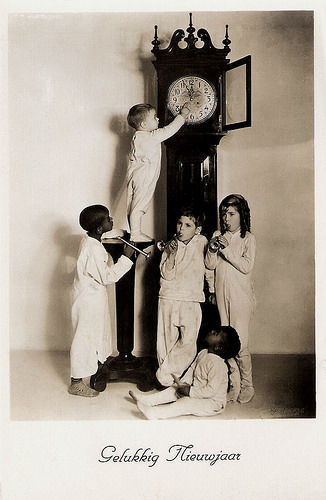
Our Gang. Dutch postcard. Photo: a publicity shot of the Little Rascals a.k.a. Our Gang with Dickie Moore in the middle. Caption: "Gelukkig Nieuwjaar" (Happy New Year).
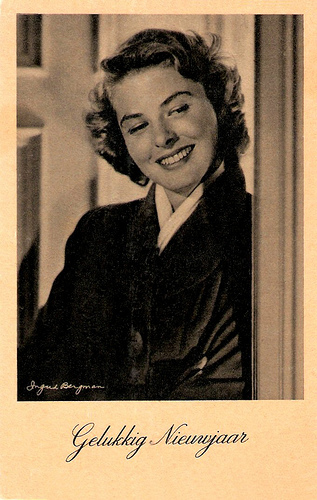
Ingrid Bergman . Dutch postcard. Sent by mail in 1950. Caption: Gelukkig Nieuwjaar! means Happy New Year!
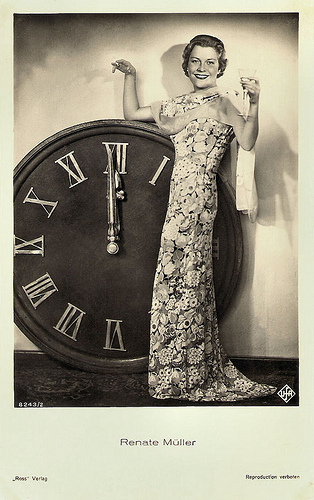
Renate Müller . German postcard by Ross Verlag, no. 8243/2, 1933-1934. Photo: Ufa.
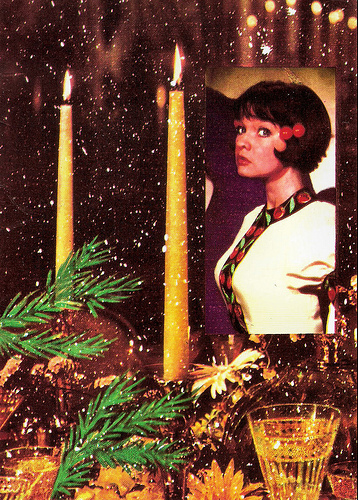
Margareta Pislaru . Romanian postcard by Casa Filmului Acin.
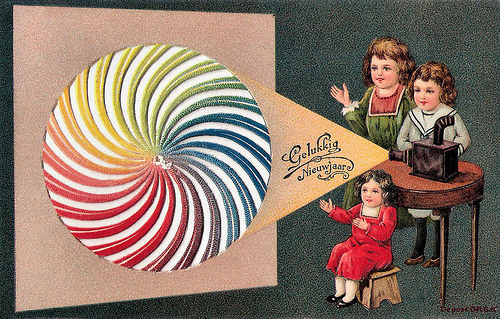
Dutch postcard by L. & B. -B. Sent by mail in 1925.
Thanks for your friendship in 2017. Special thanks to Ivo, Carla, Marlene, Didier, Tatiana, David and Egbert, for sharing their postcards and thoughts with EFSP. I've updated the Index above and also made a new page for the Film Specials. I hope to see you here again in 2018!

Our Gang. Dutch postcard. Photo: a publicity shot of the Little Rascals a.k.a. Our Gang with Dickie Moore in the middle. Caption: "Gelukkig Nieuwjaar" (Happy New Year).

Ingrid Bergman . Dutch postcard. Sent by mail in 1950. Caption: Gelukkig Nieuwjaar! means Happy New Year!

Renate Müller . German postcard by Ross Verlag, no. 8243/2, 1933-1934. Photo: Ufa.

Margareta Pislaru . Romanian postcard by Casa Filmului Acin.

Dutch postcard by L. & B. -B. Sent by mail in 1925.
Thanks for your friendship in 2017. Special thanks to Ivo, Carla, Marlene, Didier, Tatiana, David and Egbert, for sharing their postcards and thoughts with EFSP. I've updated the Index above and also made a new page for the Film Specials. I hope to see you here again in 2018!
Published on December 31, 2017 15:01
December 30, 2017
Stars Who Passed Away in 2017
On the last day of the year, EFSP remembers twelve stars of the European cinema we had to say goodbye to in 2017. Thanks for your films which will live on forever.
27 January: Emmanuelle Riva (1927–2017)
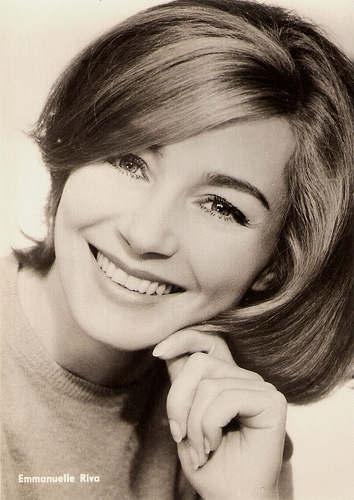
East-German postcard by VEB Progress Filvertrieb, Berlin, no. 1269, 1969. Retail price: 0,20 M. Photo: Unifrance Film. Publicity still for Berufsrisiko/Les risques du métier (André Cayatte, 1967).
On Friday 27 January, French actress Emmanuelle Riva passed away at the age of 89. She became well-known for her roles in the classic Nouveau Vague films Hiroshima mon amour (Alain Resnais, 1959) and Léon Morin, prêtre (Jean-Pierre Melville, 1961). In her 80s, Emmanuelle Riva became an icon for world cinema all over again with Michael Haneke's Amour (2012). Riva received both the Bafta and the César award for her role as the retired music teacher Anne in Amour. She was also nominated for an Oscar for her touching performance.
22 March: Tomas Milian (1933-2017)
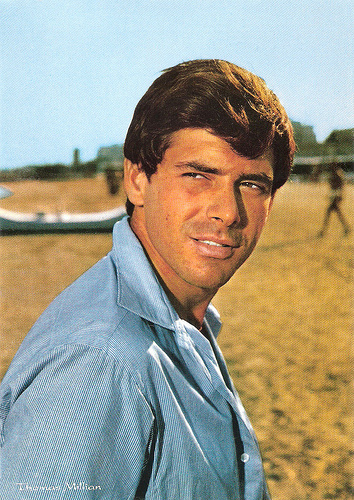
Italian postcard by Rotalfoto, Milano, in the series Artisti di sempre, no. 118.
In March, Cuban-American actor Tomas Milian passed away at the age of 84. He worked extensively in Italian films from the early 1960s to the late 1980s. Milian played neurotic and sadistic killers in several Spaghetti Westerns of the 1960s and lone-wolf anti-heroes in violent action and police thrillers of the 1970s. Very popular in Italy were his crime-comedies of the late 1970s and 1980s. Besides these genre films, he worked with such prolific directors as Mauro Bolognini, Luchino Visconti, Bernardo Bertolucci and Michelangelo Antonioni.
18 April: Yvonne Monlaur (1939-2017)
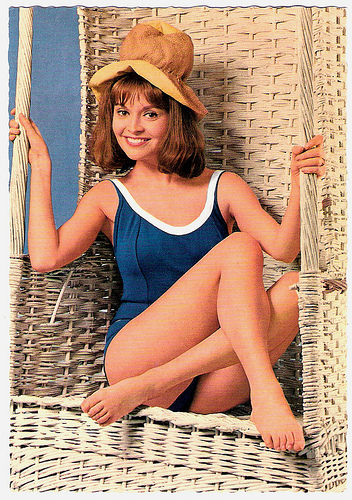
German postcard by Krüger, no. 902/395. Photo: Gérard Decaux.
French film actress Yvonne Monlaur passed away in April at the age of 77. She starred in several European film productions of the late 1950s and 1960s. The glamorous French starlet is best known for her roles in a few Hammer horror films.
23 May: Roger Moore (1927-2017)
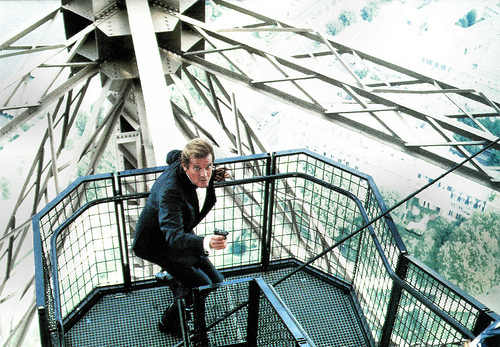 14
14
Dutch postcard by Loeb Uitgevers BV, Amsterdam, 1985. Photo: Eon Productions / Gilrose Publications / Danjaq S.A. Publicity still for A View To A Kill (John Glen, 1985).
British actor Roger Moore died in May. He will always be remembered as the guy who replaced Sean Connery in the James Bond series, but he was also our favourite Ivanhoe, Saint and Persuader on TV. Roger Moore was 89.
17 June: Anneliese Uhlig (1918-2017)
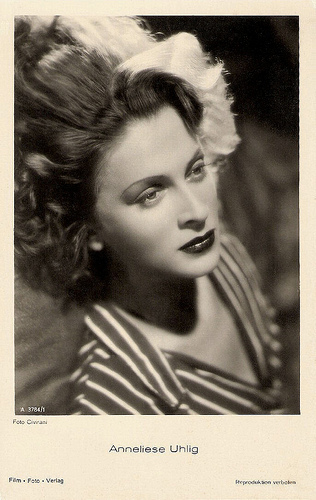
German Postcard by Film-Foto-Verlag, no. A 3784/1, 1941-1944. Photo: Civirani.
German actress Anneliese Uhlig passed away at the age of 98. She was an elegant and enchanting femme fatale of Ufa crime films of the 1940s. The classic beauty unwillingly bewitched Joseph Goebbels. After the war she also worked internationally as a journalist, theatre producer and university teacher. She became an American citizen and died in Santa Cruz in California.
8 July: Elsa Martinelli (1935-2017)
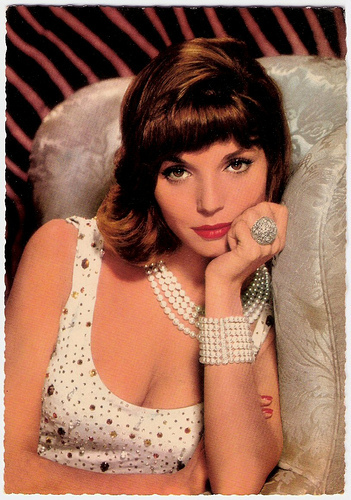
German postcard by Krüger, no. 902/255.
Glamorous Italian actress and former fashion model Elsa Martinelli died in July. She showed her beautiful curves in many European and Hollywood productions of the 1950s and 1960s, but somehow she never became the star she was destined to become in the mid-1950s. Martinelli was 82.
31 July: Jeanne Moreau (1928-2017)

French postcard by E.D.U.G., no. 81. Photo: Sam Lévin.
French actress Jeanne Moreau died this summer at the age of 89. Moreau was the personification of French womanhood and sensuality. She had a diverse career: she was a magnificent stage and film actress, a producer, screenwriter and film director, a successful singer with a substantial recording career, and a theatre and opera director. Throughout her long career in the cinema with more than 130 films, Jeanne Moreau worked with some of the most notable film directors ever. She combined off-kilter beauty with strong character in Nouvelle Vague classics as Ascenseur pour l'échafaud (Louis Malle, 1958) and Les amants (Louis Malle, 1959). Her role as the flamboyant, free-spirited Catherine with her devil-may-care sensuality in Jules et Jim (François Truffaut, 1962) is one of the greatest performances in the history of the cinema.
20 August: Margot Hielscher (1919-2017)
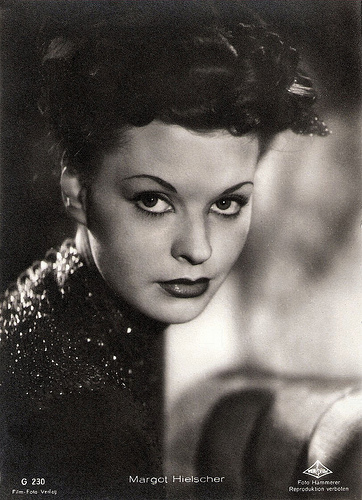
German postcard by Film-Foto-Verlag, no. G 230. 1941-1944. Photo: Hammerer / Wien-Film.
German singer, film actress and costume designer Margot Hielscher (1919-2017) passed away in August. During her long career, she appeared in 60 films and 200 TV productions. Hielscher also represented Germany twice at the Eurovision Song Contest, in 1957 and 1958. Hielscher
26 September 2017: Kveta Fialová (1929-2017)
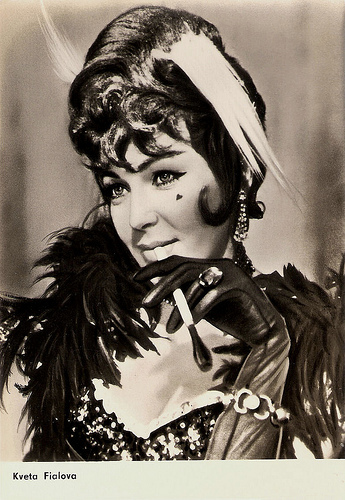
East-German postcard by VEB Progress Film-Vertrieb, no. 2.125, 1964. Photo: Limonádový Joe aneb Konská opera/Lemonade Joe (Oldrich Lipský, 1964).
In September Czech actress Květa Fialová passed away at the age of 88. In her country, she was a popular theatre, film and television diva. Internationally she is best known for her role as bar singer Tornado Lou in the Western parody Limonádový Joe aneb Konská opera/Lemonade Joe (Oldrich Lipský, 1964).
17 October: Danielle Darrieux (1917-2017)
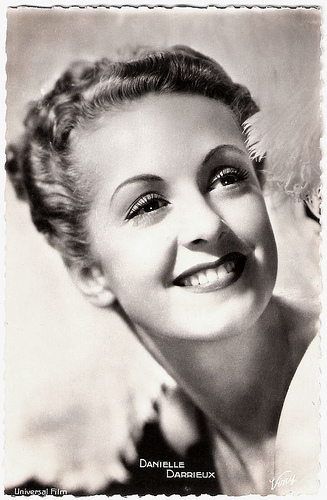
French postcard by Viny, no. 70. Photo: Universal Film.
In October, French actress and singer Danielle Darrieux (1917-2017) passed away. She was a beautiful, international leading lady whose eight-decade career was among the longest in film history. From her film debut in 1931 on she played in more than 110 films in which she progressed from playing pouting teens to worldly sophisticates. In the early 1950s she starred in three classic films by Max Ophüls, and she played the mother of Catherine Deneuve in five films! Danielle Darrieux was 100.
10 November 2017: Erika Remberg (1932-2017)
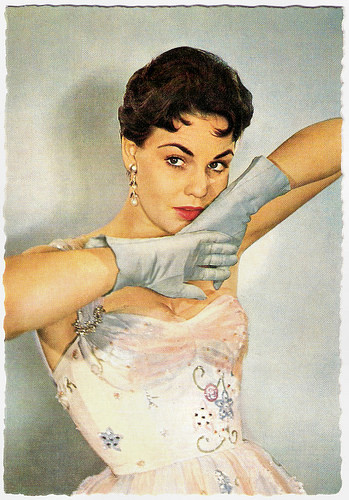
German postcard by WS-Drück, Wanne-Eickel, no. F 100. Photo: Huster.
In November Erika Remberg passed away at the age of 85. Long ago we saw the beautiful Austrian film actress in the tearjerker Laila/Make Way for Lila (Rolf Husberg, 1958), as a foundling who is adopted and raised by a Lapland chieftain. Remberg appeared in 31 films between 1950 and 1970, but we want to remember her as lovely Laila.
6 December: Johnny Hallyday (1943-2017)
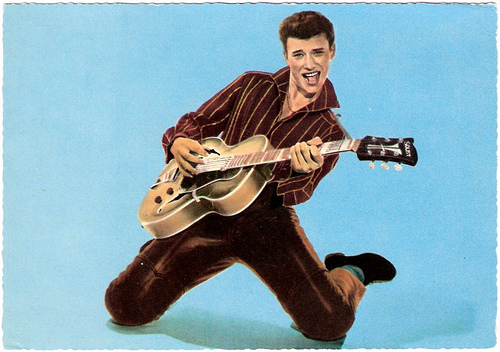
German postcard by ISV, no. H 85.
The father of French Rock and Roll is dead. Flamboyant singer and actor Johnny Hallyday passed away on 6 December. He was a European teen idol in the 1960s with record-breaking crowds and mass hysteria, but he never became popular in the English-speaking market. In later years he concentrated on being an actor and appeared in more than 35 films. Hallyday was 74.
27 January: Emmanuelle Riva (1927–2017)

East-German postcard by VEB Progress Filvertrieb, Berlin, no. 1269, 1969. Retail price: 0,20 M. Photo: Unifrance Film. Publicity still for Berufsrisiko/Les risques du métier (André Cayatte, 1967).
On Friday 27 January, French actress Emmanuelle Riva passed away at the age of 89. She became well-known for her roles in the classic Nouveau Vague films Hiroshima mon amour (Alain Resnais, 1959) and Léon Morin, prêtre (Jean-Pierre Melville, 1961). In her 80s, Emmanuelle Riva became an icon for world cinema all over again with Michael Haneke's Amour (2012). Riva received both the Bafta and the César award for her role as the retired music teacher Anne in Amour. She was also nominated for an Oscar for her touching performance.
22 March: Tomas Milian (1933-2017)

Italian postcard by Rotalfoto, Milano, in the series Artisti di sempre, no. 118.
In March, Cuban-American actor Tomas Milian passed away at the age of 84. He worked extensively in Italian films from the early 1960s to the late 1980s. Milian played neurotic and sadistic killers in several Spaghetti Westerns of the 1960s and lone-wolf anti-heroes in violent action and police thrillers of the 1970s. Very popular in Italy were his crime-comedies of the late 1970s and 1980s. Besides these genre films, he worked with such prolific directors as Mauro Bolognini, Luchino Visconti, Bernardo Bertolucci and Michelangelo Antonioni.
18 April: Yvonne Monlaur (1939-2017)

German postcard by Krüger, no. 902/395. Photo: Gérard Decaux.
French film actress Yvonne Monlaur passed away in April at the age of 77. She starred in several European film productions of the late 1950s and 1960s. The glamorous French starlet is best known for her roles in a few Hammer horror films.
23 May: Roger Moore (1927-2017)
 14
14Dutch postcard by Loeb Uitgevers BV, Amsterdam, 1985. Photo: Eon Productions / Gilrose Publications / Danjaq S.A. Publicity still for A View To A Kill (John Glen, 1985).
British actor Roger Moore died in May. He will always be remembered as the guy who replaced Sean Connery in the James Bond series, but he was also our favourite Ivanhoe, Saint and Persuader on TV. Roger Moore was 89.
17 June: Anneliese Uhlig (1918-2017)

German Postcard by Film-Foto-Verlag, no. A 3784/1, 1941-1944. Photo: Civirani.
German actress Anneliese Uhlig passed away at the age of 98. She was an elegant and enchanting femme fatale of Ufa crime films of the 1940s. The classic beauty unwillingly bewitched Joseph Goebbels. After the war she also worked internationally as a journalist, theatre producer and university teacher. She became an American citizen and died in Santa Cruz in California.
8 July: Elsa Martinelli (1935-2017)

German postcard by Krüger, no. 902/255.
Glamorous Italian actress and former fashion model Elsa Martinelli died in July. She showed her beautiful curves in many European and Hollywood productions of the 1950s and 1960s, but somehow she never became the star she was destined to become in the mid-1950s. Martinelli was 82.
31 July: Jeanne Moreau (1928-2017)

French postcard by E.D.U.G., no. 81. Photo: Sam Lévin.
French actress Jeanne Moreau died this summer at the age of 89. Moreau was the personification of French womanhood and sensuality. She had a diverse career: she was a magnificent stage and film actress, a producer, screenwriter and film director, a successful singer with a substantial recording career, and a theatre and opera director. Throughout her long career in the cinema with more than 130 films, Jeanne Moreau worked with some of the most notable film directors ever. She combined off-kilter beauty with strong character in Nouvelle Vague classics as Ascenseur pour l'échafaud (Louis Malle, 1958) and Les amants (Louis Malle, 1959). Her role as the flamboyant, free-spirited Catherine with her devil-may-care sensuality in Jules et Jim (François Truffaut, 1962) is one of the greatest performances in the history of the cinema.
20 August: Margot Hielscher (1919-2017)

German postcard by Film-Foto-Verlag, no. G 230. 1941-1944. Photo: Hammerer / Wien-Film.
German singer, film actress and costume designer Margot Hielscher (1919-2017) passed away in August. During her long career, she appeared in 60 films and 200 TV productions. Hielscher also represented Germany twice at the Eurovision Song Contest, in 1957 and 1958. Hielscher
26 September 2017: Kveta Fialová (1929-2017)

East-German postcard by VEB Progress Film-Vertrieb, no. 2.125, 1964. Photo: Limonádový Joe aneb Konská opera/Lemonade Joe (Oldrich Lipský, 1964).
In September Czech actress Květa Fialová passed away at the age of 88. In her country, she was a popular theatre, film and television diva. Internationally she is best known for her role as bar singer Tornado Lou in the Western parody Limonádový Joe aneb Konská opera/Lemonade Joe (Oldrich Lipský, 1964).
17 October: Danielle Darrieux (1917-2017)

French postcard by Viny, no. 70. Photo: Universal Film.
In October, French actress and singer Danielle Darrieux (1917-2017) passed away. She was a beautiful, international leading lady whose eight-decade career was among the longest in film history. From her film debut in 1931 on she played in more than 110 films in which she progressed from playing pouting teens to worldly sophisticates. In the early 1950s she starred in three classic films by Max Ophüls, and she played the mother of Catherine Deneuve in five films! Danielle Darrieux was 100.
10 November 2017: Erika Remberg (1932-2017)

German postcard by WS-Drück, Wanne-Eickel, no. F 100. Photo: Huster.
In November Erika Remberg passed away at the age of 85. Long ago we saw the beautiful Austrian film actress in the tearjerker Laila/Make Way for Lila (Rolf Husberg, 1958), as a foundling who is adopted and raised by a Lapland chieftain. Remberg appeared in 31 films between 1950 and 1970, but we want to remember her as lovely Laila.
6 December: Johnny Hallyday (1943-2017)

German postcard by ISV, no. H 85.
The father of French Rock and Roll is dead. Flamboyant singer and actor Johnny Hallyday passed away on 6 December. He was a European teen idol in the 1960s with record-breaking crowds and mass hysteria, but he never became popular in the English-speaking market. In later years he concentrated on being an actor and appeared in more than 35 films. Hallyday was 74.
Published on December 30, 2017 22:00
Paul van Yperen's Blog
- Paul van Yperen's profile
- 13 followers
Paul van Yperen isn't a Goodreads Author
(yet),
but they
do have a blog,
so here are some recent posts imported from
their feed.



